Vol. 69, No. 3 (2020)
2020-02-05
INVITED REVIEW
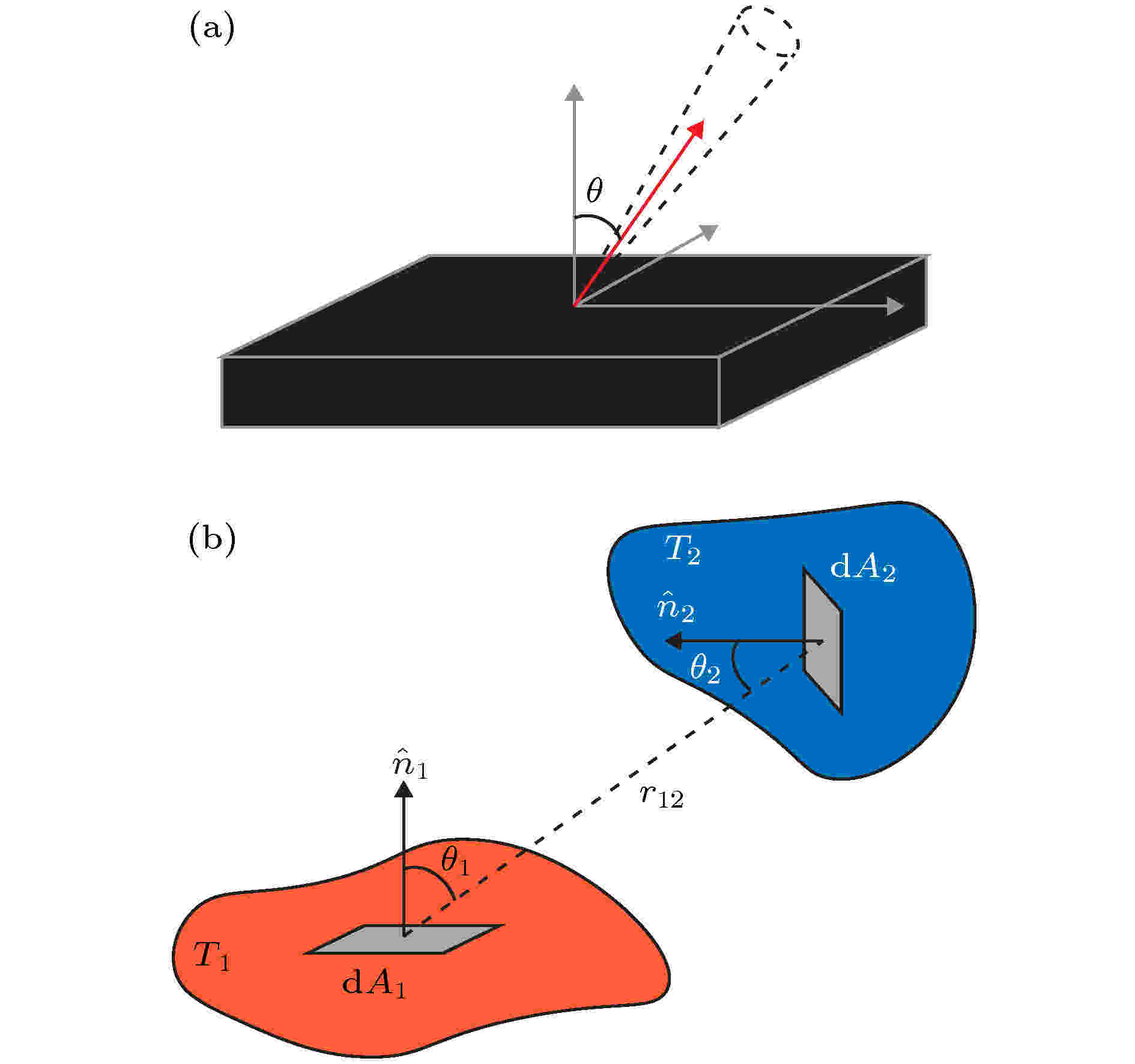
COVER ARTICLE
2020, 69 (3): 036501.
doi: 10.7498/aps.69.20191906
Abstract +
Thermal radiation, as a ubiquitous physical phenomenon, plays an important role in various research fields of science and engineering. Traditional understanding of thermal radiation mainly relies on Planck’s law, which describes the energy exchanging efficiency of entire thermal radiation process. However, recent studies indicated that comparing with the macroscopic object obeying Planck’s law, the thermal radiation in nanophotonic structures is obviously abnormal. This is due to the fact that the nanostructures’ featured size or neighboring space are much smaller than the thermal wavelength. It is important to notice that by well designing the material, size, and structure pattern, the thermal radiation is tunable and controllable. Furthermore, the nanophotonic structures enabling the radiative cooling effects promise to possess the tremendous applications including energy, ecology, etc. In this review paper, firstly, we briefly describe the fundamental theory of thermal radiation, as well as the history and latest progress, such as, enhanced radiative heat transfer, the near-field radiation in two-dimensional materials, and the overall far-field enhancement. Secondly, we focus on the newly available daytime radiative cooling system, which is based on metamaterials or desired nanophotonic structures, pursuing the best cooling performances. Finally, we detail the checklists of remarkable applications, ranging from building cooling and dew collection to solar cell cooling. In addition, we also point out the broad future of radiation cooling technology of nanometer optical materials in promoting the management and transformation of desert ecological environment.
Original Articles

2020, 69 (3): 038702.
doi: 10.7498/aps.69.20191346
Abstract +
Magnetic resonance imaging is a medical imaging technique in which the phenomenon of nuclear magnetic resonance is used. This technique is widely used in clinical and scientific research at present. The diffusion of water molecules is isotropic in a homogeneous medium, while it is anisotropic in the structure of human tissue. Magnetic resonance diffusion tensor imaging (DTI) is for studying the microscopic structure inside body by using the water molecules’ diffusion effect which will reduce the signal intensity of magnetic resonance. Besides, it can quantitatively study the anisotropy of water molecules in three-dimensional space, and thus acquiring important pathological and physiological information without invading in vivo. In order to obtain the accurate result of the anisotropic diffusion of water molecules, according to a certain scheme, it is necessary to sequentially use diffusion sensitive gradient (DSG) magnetic fields in different diffusion orientations to measure the diffusion coefficient of water molecules for estimating the diffusion tensor. The precision of estimating diffusion tensor is affected by the applied DSG encoding scheme, and it is usually necessary to use a large number of linearly independent and evenly spatial distributions of DSG magnetic fields in order to make the tensor measurement result more accurate. Diffusion spectroscopy imaging technique and high angular resolution diffusion imaging (HARDI) technique are proposed for more complex fiber bundles crossing in human tissue, one of which, HARDI, has higher requirement for the number and the direction distribution uniformity of DSGs. In this paper, the basic principle of DTI and the DSG encoding schemes are reviewed, which includes completely random scheme, heuristic scheme, regular polyhedral scheme, numerically optimized scheme, etc. For the above various schemes their respective advantages and limitations are analyzed. At present, the Golden Ratio method is to be used in a new spherical DSG encoding scheme which meets the requirements for HARDI and can offer more accurate tensor estimation results in face of the corruption of data sets encountered in clinical practice.
GENERAL

2020, 69 (3): 030301.
doi: 10.7498/aps.69.20191173
Abstract +
The Hamiltonians of classical quantum systems are Hermitian (self-adjoint) operators. The self-adjointness of a Hamiltonian not only ensures that the system follows unitary evolution and preserves probability conservation, but also guarantee that the Hamiltonian has real energy eigenvalues. We call such systems Hermitian quantum systems. However, there exist indeed some physical systems whose Hamiltonians are not Hermitian, for instance, $ {\mathcal{P}}{\mathcal{T}} $ -symmetry quantum systems. We refer to such systems as non-Hermitian quantum systems. To discuss in depth $ {\mathcal{P}}{\mathcal{T}} $ -symmetry quantum systems, some properties of conjugate linear operators are discussed first in this paper due to the conjugate linearity of the operator $ {\mathcal{P}}{\mathcal{T}}, $ including their matrix represenations, spectral structures, etc. Second, the conjugate linear symmetry and unbroken conjugate linear symmetry are introduced for linear operators, and some equivalent characterizations of unbroken conjugate linear symmetry are obtained in terms of the matrix representations of the operators. As applications, $ {\mathcal{P}}{\mathcal{T}} $ -symmetry and unbroken $ {\mathcal{P}}{\mathcal{T}} $ -symmetry of Hamiltonians are discussed, showing that unbroken $ {\mathcal{P}}{\mathcal{T}} $ -symmetry is not closed under taking tensor-product operation by some specific examples. Moreover, it is also illustrated that the unbroken $ {\mathcal{P}}{\mathcal{T}} $ -symmetry is neither a sufficient condition nor a necessary condition for Hamiltonian to be Hermitian under a new positive definite inner product.

EDITOR'S SUGGESTION
2020, 69 (3): 030601.
doi: 10.7498/aps.69.20191525
Abstract +
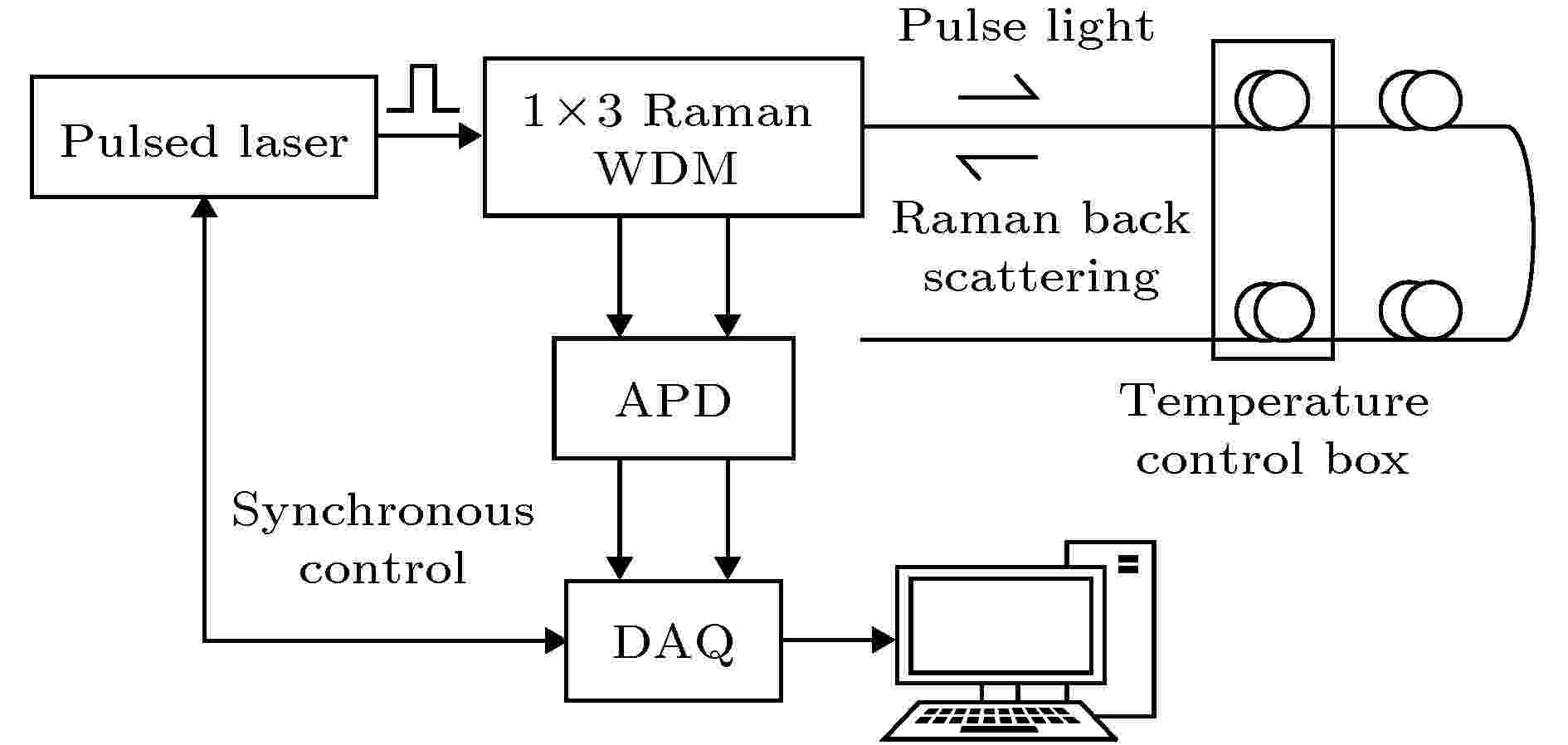
2020, 69 (3): 030701.
doi: 10.7498/aps.69.20191456
Abstract +
The temperature error caused by the essential loss and the additional loss of Stokes light and anti-Stokes light widely exist in the distributed optical fiber temperature sensor (DTS). According to the temperature demodulation principle of the DTS, a method of fitting the attenuation difference between Stokes light and anti-Stokes light is proposed, which can realize the temperature self-compensation to reduce the temperature measurement error. Two parts at the different positions of the sensing fiber are regarded as the reference section and the temperature measuring section, respectively. The optical signal of the reference section is used as a parameter when demodulating the temperature and fitting the attenuation difference, and the attenuation difference between the Stokes light and the anti-Stokes light is multi-order fitted by the optical signal of the temperature measuring section, then the multi-order fitting results are used to demodulate the temperature for reducing the temperature error caused by the essential loss and additional loss of the Stokes light and anti-Stokes light, in order to implement the preliminary correction of the temperature. Three groups of the different measuring temperature values at the same position of the optical fiber as well as their corresponding signal values are taken in calculation for eliminating the Rayleigh noise, and the relationship of Rayleigh noise with fiber length and temperature are analyzed, and thus further calculating the Rayleigh noise based on the fitting attenuation difference. The influence of the multi-order attenuation difference on the error in temperature measurement and that on the elimination of the Rayleigh noise are compared with each other, and the Rayleigh noise error caused by the essential loss and additional loss of the Stokes light and anti-Stokes light are reduced, then the temperature is corrected again by eliminating the Rayleigh noise. The effect of the multi-order attenuation difference fitting result on the temperature measurement error and on the elimination of Rayleigh noise are analyzed and compared with each other, then the optimal fitting order is obtained. After fitting the additional error at the temperature measurement section that is caused by the additional loss at the reference section, the temperature compensation is carried out by the fitting result, then the final temperature correction is completed. The experimental results show that the temperature correction effect is best by using the first-order linear fitting results in a temperature range of 30-90 ℃, and the temperature measurement error is reduced from 10.50 ℃ to 0.90 ℃ after being corrected three times.
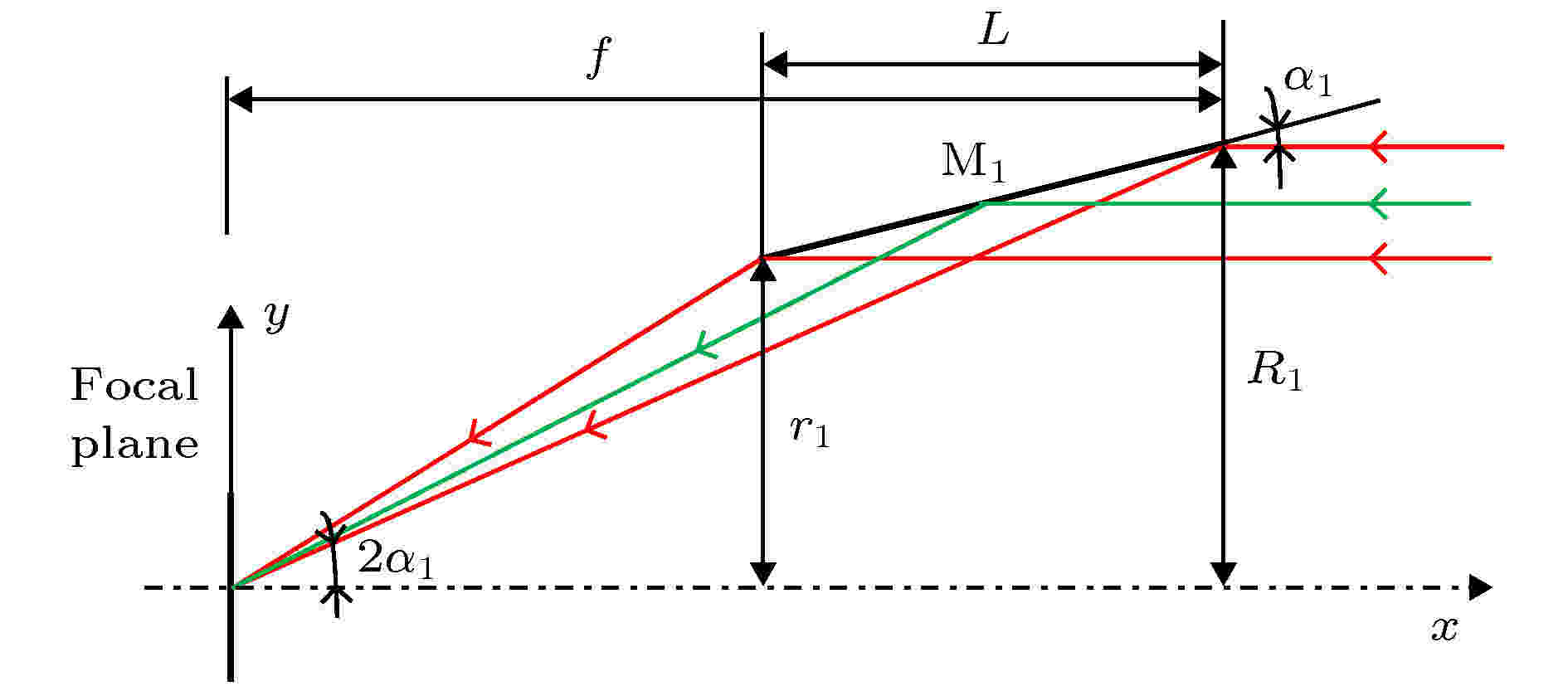
2020, 69 (3): 030702.
doi: 10.7498/aps.69.20191446
Abstract +
On November 10, 2016, China launched an X-ray pulsar navigation test satellite (XPNAV-1) to investigate the X-ray pulsar navigation technology, and a lot of scientific observation data have been obtained. The X-ray grazing incidence optics is a critical component of the focusing pulsar telescope. It plays an important role in increasing the effective area and enhancing the sensitivity of the telescope. It is also the first grazing incidence optics verified in orbit in China. According to the characteristic that the times of arrival (TOA) of X-ray photons are measured in pulsar navigation, the grazing incidence focusing optics based on single-reflection paraboloid mirror is designed, and manufacturable mirror design parameters are obtained through theoretical calculation and derivation. The theoretical effective area of the designed optics is 15.6 cm2 at 1 keV. The designed optics is then simulated to evaluate its focusing performance. It meets the focusing requirement in the full field of view. The electroforming nickel replication process used for manufacturing the mirrors for XMM-Newton and eRosita missions is investigated. A super-smooth mandrel is firstly fabricated and used for follow-up replication. An about-100 nm-thick gold layer is deposited on the mandrel, and serves as the reflection and release layer of the mirror. The nickel substrate of the mirror is electroformed on the gold layer. The mirror is finally obtained by releasing the nickel and gold layer from the mandrel. The patterns and roughness of the mandrel are then replicated onto the inner surface of the mirror. The 4-layered mirror is fabricated for the optics. The reflectivity for each layer of the 4-layered mirror is then measured with a dedicated facility on 4B7B beamline of BSRF. The effective area of the optics based on the above-measured reflectivity is 13.2 cm2 at 1 keV. Finally, according to the in-orbit observation data, the effective area of the optical system is evaluated to be a typical value of 4.22 cm2 at 1 keV, which is less than the ground-tested value. The reason for this is analyzed and it turns out to be due to the thermal deformation of mechanical structure and contamination of the mirrors. Therefore, in our future work, we will strictly control the environmental factors and implement space environmental adaptability design, while increasing the accuracy of the optics.
NUCLEAR PHYSICS
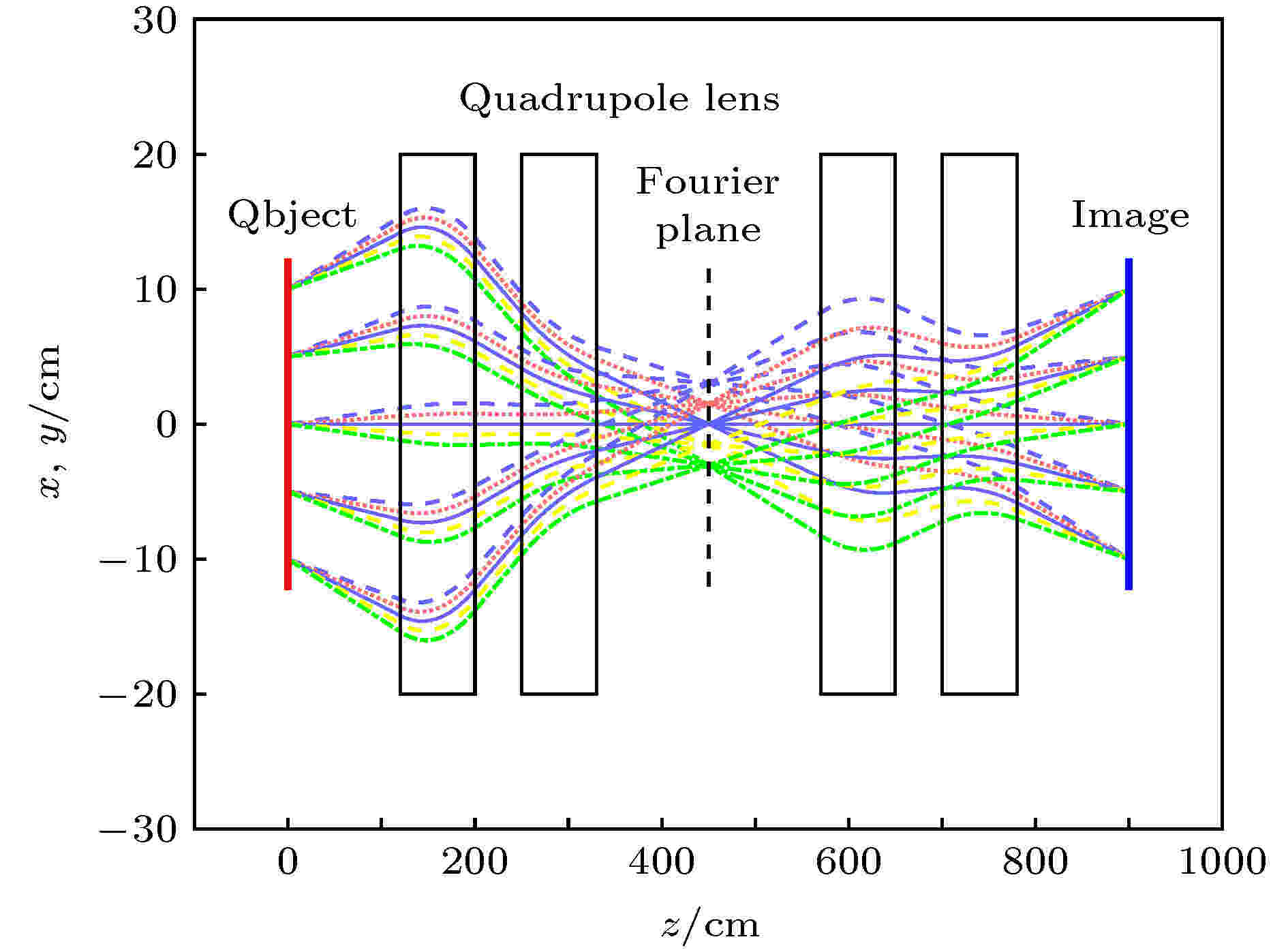
2020, 69 (3): 032901.
doi: 10.7498/aps.69.20191691
Abstract +
The angle-cut collimator plays an important role in high-energy proton radiography. By using the collimator, the image contrast can be improved, and the material diagnosis and density reconstruction can be realized through secondary imaging. As all these techniques depend on the flux value, it is of great significance to reduce the error of the detected flux value. The ideal collimator is a much thin surface, but thick enough to block protons outside the collimation region. It is designed by stretching the aperture of the collimation plane. The shape is cylindrical, and it will increase the error of the flux value with the angle truncation. The initial bunch is defined and the phase diagram of the bunch within the angle-cut is ideal in the theoretical model. The equation of designing the collimator is given by theoretical analysis. It is given by the transfer matrix, the radius of the object and the angle-cut. The pore structure is oval-shaped by calculating and simulating. The proton imaging system of 1.6 GeV is established by Geant4 program, and the detector is ideal. The round copper plate and the concentric spheres are chosen as objects respectively. The parameters of the designed collimator is given by this method. The ideal collimator, tensile collimator and designed collimator are used in simulation, the radius of object is 5 cm and the angle-cut is 2 mrad and 3.5 mrad. The results show that when using the ideal and the designed angle-cut collimator, the flux distributions are in good agreement, while when using the tensile collimator, the result is quite different from that obtained by using the ideal collimator. Therefore, the collimator designed by this method can effectively reduce the error of the detected flux value.
ATOMIC AND MOLECULAR PHYSICS
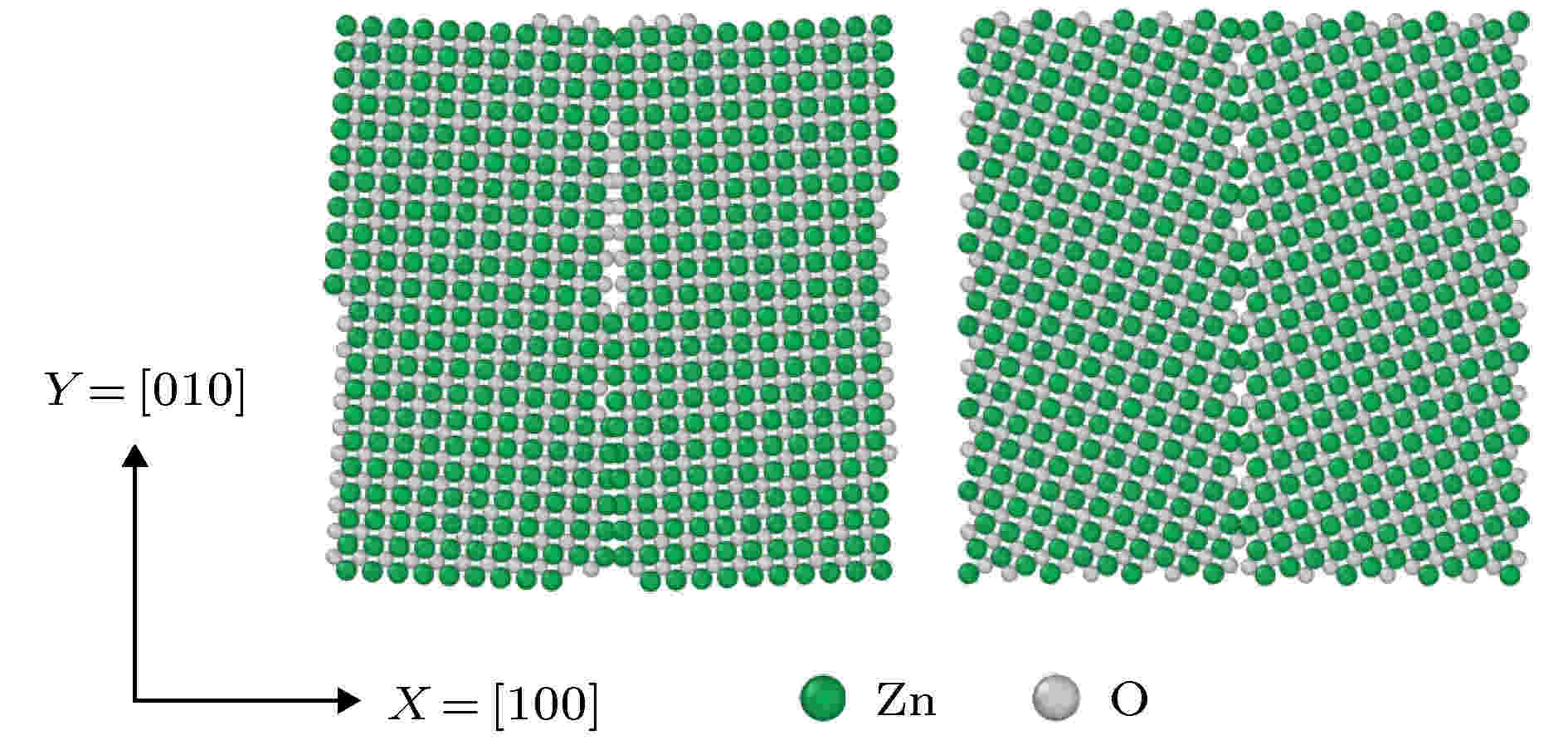
2020, 69 (3): 033101.
doi: 10.7498/aps.69.20190627
Abstract +
Zinc oxide (ZnO), as a conventional semiconductor material, has excellent characteristics, such as piezoelectricity, photoelectricity, gas sensitivity, etc. With the improvement of nanopreparation technology, different types of nanostructrued ZnO compounds have appeared and their heat conductions have become a main research topic in nanodevices. In order to study the effects of grain boundary on the thermal properties of materials of this kind, bicrystal ZnO containing small-angle and high-angle grain boundaries are constructed by the embedded dislocation line and coincidence site lattice method. The variation of grain boundary energy with tilt angle is studied by the non-equilibrium molecular dynamics simulation. In addition, the dislocation density is calculated by using the Frank-Bilby formula. Our results show that the grain boundary energy and dislocation density increase with the increase of tilt angle in a small-angle region, and they tend to be stable in a high-angle region. The tilt angle of 36.86° is defined as the transition angle. The trend of the Kapitza resistance is the same as that of the grain boundary energy and satisfies the theoretical value from the extended Read-Shockley model. Furthermore, it is found that both the Kapitza resistance and thermal conductivity have a significant size effect. When the sample length is between 23.2 nm and 92.6 nm, the Kapitza resistance decreases sharply with the increase of the length and then tends to be stable. The thermal conductivity of the sample increases with length increasing, but is always less than that of the single crystal. At the same time, temperature is an important factor affecting the heat transport properties. The Kapitza resistance and thermal conductivity decrease with temperature increasing. At different temperatures, the Kapitza resistance of 38.94° grain boundary sample is greater than that of 5.45° grain boundary sample. In order to further explore the influence mechanism of grain boundary angle on heat conduction, the phonon state density of 5.45° and 38.94° grain boundary sample are calculated. The results indicate that the high-angle grain boundary has stronger scattering for acoustic branch phonons and the peak frequency becomes lower, whereas the optical branch ones have almost no effect on the heat conduction.

2020, 69 (3): 033401.
doi: 10.7498/aps.69.20191514
Abstract +
In order to improve the efficiency of the single event effect (SEE) experiments on the 100 MeV proton cyclotron of China Institute of Atomic Energy, a binary energy degrader that can lower the initial proton energy to other values rapidly is designed for the 100 MeV protons provided by the accelerator. The energy degrader is comprised of six aluminum plates of 0.5, 1, 2, 4, 8, 16 and 32 mm at thickness, where the thickness of the latter plate is twice that of the previous one. We introduce the concept of relative thickness, which can also represent the order of the energy of the produced protons, and the state or operation of the degrader. The energy interval of 61 protons with energy above 9.69 MeV, produced by the degrader, is between 0.84 MeV and 4.09 MeV. And their energy straggling degree is less than 10%, and full width at half maximum of the scattering angle is less than 45 mrad. So the energy degrader basically meets the requirements of the proton SEE experiments. The influence of the initial proton energy accuracy of the protons directly provided by the accelerator on the residual energy after they have passed through the degrader is discussed. It is found that the lower the residual energy, the greater the influence is. In addition, the degrader is also suitable for protons in the 70-100 MeV energy range that the accelerator can directly provide, and more continuous energy can be obtained by using more plates designed with this method. The design method of the energy reducer proposed in this paper is simple and effective, and has a strong reference value.
ELECTROMAGNETISM, OPTICS, ACOUSTICS, HEAT TRANSFER, CLASSICAL MECHANICS, AND FLUID DYNAMICS
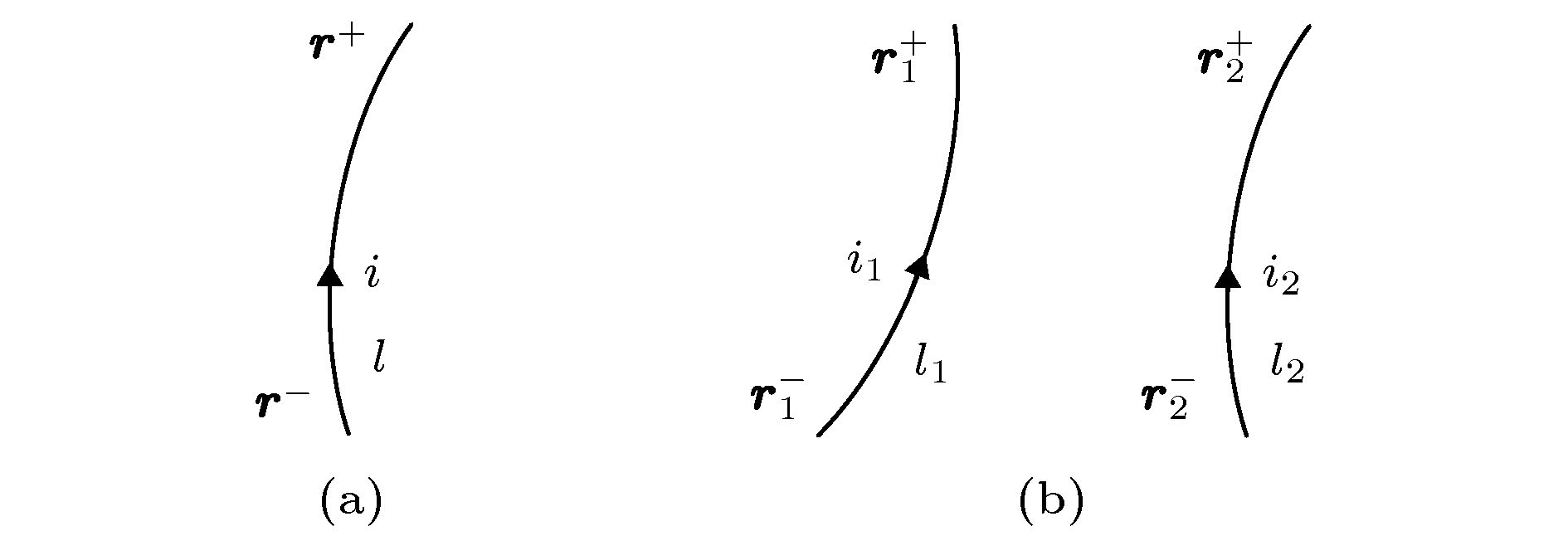
2020, 69 (3): 034101.
doi: 10.7498/aps.69.20191212
Abstract +
Traditional current-carrying model of filament conductor segment is the basic model for analyzing the magnetic field in a closed conductor loop. Although it does not satisfy the law of current continuity, it is still suitable for analyzing the magnetic field in the closed conductor loop. However, for the current distribution problem of some local multi-branch parallel-connection conductor segments in a closed conductor loop, the traditional model cannot fully reflect the interaction between magnetic fields of the local multi-branch parallel-connection conductor segments. For this reason, the displacement current model proposed in the existing literature satisfies the law of current continuity and solves the above problem well. But, there remain some problems to be solved, such as incomplete theory, inconsistency and complex formulae in the existing literature. In this paper, a conductive current-carrying model of filament conductor segment is proposed, which ensures current continuity inside, outside, and on two terminals of the filament conductor segment. The differential equation of total magnetic field with more profound physical connotation and the formulae of vector magnetic potential are derived in detail. Further, the formulae for calculating magnetic field energy and inductance of the conductive current-carrying model of filament conductor segment are proposed, which greatly reduces the computational complexity and makes up for the shortcoming of model in the existing literature. An example given in this paper verifies the correctness of the above theory and formulae.

2020, 69 (3): 034102.
doi: 10.7498/aps.69.20191586
Abstract +
Coherent X-ray diffraction imaging (CDI) method is a powerful X-ray imaging technique with high resolution up to nanometer scale. Most of the synchrotron radiation facilities and free electron laser facilities are equipped with this state-of-the-art imaging technique and have made many outstanding achievements in multiple scientific areas. Up to now, although scanning CDI (ptychography) method based on a soft X-ray source has been opened to users, the hard X-ray CDI experimental platform has not been built at Shanghai Synchrotron Radiation Facility (SSRF) which can research some relatively thick specimens and easily extend to three-dimensional imaging. As some new beamlines with undulator source were put into operation recently, it is possible and feasible to build up the CDI experimental platform with hard X-ray. In this article, we report the hard X-ray CDI experimental platform development process and preliminary experimental results of coherent diffraction pattern and image reconstruction at SSRF. Based on the operating BL19U2 biological small-angle X-ray scattering (SAXS) beamline at SSRF, the hard X-ray coherent beam is obtained through effective optical path designation at 12 keV and 13.5 keV. The hard X-ray optimization includes tuning several slits, double crystal monochromator (DCM), horizontal deflection mirror, focusing mirror system and pinhole, etc. Furthermore, hard X-ray CDI experiments are conducted. The spatial coherent length of the incident beam is also measured from the pinhole diffraction pattern. This platform can provide both conventional mode and scanning mode (ptychography) for the coherent diffraction imaging method, and the correct image reconstruction from the experimental diffraction patterns proves that the platform has the experimental capability for hard X-ray CDI. In the conventional forward scattering CDI mode, coherent diffraction patterns of pinhole are collected and used to analyse the coherence property of the optimized X-ray beam. The structure of pinhole is also reconstructed from the diffraction pattern. In the scanning CDI mode, a zone plate is used as a sample. The central area of zone plate is reconstructed correctly. About 90 nm/pixel resolution of reconstruction is achieved which is extremely dependent on the X-ray flux density from the undulator source emission. Hard X-ray CDI experimental platform based on the synchrotron radiation facility is first built in China. It will provide effective software and hardware supporting for the development and application of hard X-ray CDI experiments in China in the future.

2020, 69 (3): 034201.
doi: 10.7498/aps.69.20191340
Abstract +
The Talbot effect is a near-field diffraction effect that occurs in periodic structures. In a circular periodic structure with a point source as incident light, it has been found that there is no self-imaging effect of the grating at a certain propagation distance. In this paper, we combine the conformal transformation with the Talbot effect and work out a special medium in the physical space, which allows the circular grating to have a Talbot effect within it. The refractive index distribution generated by conformal transformation is calculated and the corresponding self-imaging radius expression is obtained. Lumerical product is used for simulation verification, and the applicable condition of the method is summarized. We separately carry out the simulations of a circular grating with and without the designed medium. Light field distributions in the two simulations differ from each other. The light field in the second situation shares more similarities with the light field of a plane grating than the first simulation. What is more, in the second situation, we can work out a certain Talbot radius, and the light field distribution at the calculated Talbot radius is quite similar to that at the circular grating. But for the first situation, we cannot calculate a certain Talbot radius and can obtain only the radius of the ring with highest self-imaging accuracy by comparing light field at each distance with the grating structure. We find that the small period of the circular grating we used in the second situation makes the light field at Talbot radius furcate. So we carry out a third simulation of a circular grating with a large period compared with the incident wavelength. The self-imaging result matches the grating structure quite well. However, there are some limits in this method. According to the conformal transformation, the refractive index near the center tends to be infinite, so we have to remove the medium near the center. Also, when the radius is big enough, refractive index there can be smaller than 1, so the Talbot effect should happen within this radius. In conclusion, we show that the transformation optics can be introduced into the self-imaging of circular gratings, and thus greatly expanding the range of applications for the Talbot effect.

2020, 69 (3): 034202.
doi: 10.7498/aps.69.20191218
Abstract +
The spin-orbit interaction (SOI) of light refers to the mutual conversion and coupling between the spin angular momentum and orbital angular momentum. It is a fundamental effect in optics, and has been widely found in many basic optical processes, such as reflection, refraction, scattering, focusing, and imaging. So it plays an important role in the fields of optics, nanophotonics, and plasmonics, and has great potential applications in precision measurement and detection, information storage and processing, particle manipulation, and various functional photonic devices. Recently, it has been found that a circularly polarized light beam normally passing through an isotropic sharp interface can undergo an SOI process, that is, part of the incident beam experiences a spin-flip and acquires a spin-dependent vortex phase with a topological charge of $ \pm2 $ . However, the physical origin of this phase and the role of the interface played in the SOI process are still unclear at present. In this work, a Fresnel Jones matrix is first established to describe the relationship between the incident beam and the transmitted beam, based on which we unveil that the vortex phase is in fact a spin-redirection Berry geometric phase, originating from the topological structure of the beam itself. The properties of the interface affect the conversion efficiency of the SOI. This kind of SOI is very similar to that in the azimuthal Pancharatnam-Berry phase elements. The difference lies in the fact that the Pancharatnam-Berry phase originates from the external anisotropy of the composite material. Generally, the efficiency of this SOI is extremely low, which limits its applications. The existing method of enhancing this SOI employs an isotropic epsilon-near-zero slab, whose maximum efficiency can reach only about 20%. Since the anisotropic medium (such as birefringent uniaxial crystals) has more degrees of freedom, we further point out that the weak SOI can be greatly enhanced by an optically thin uniaxial slab whose optical axis is parallel to the normal direction of the interface. And under certain conditions, the conversion efficiency can reach 100%. Our study not only establishes a simple and convenient full-wave theory for this SOI, but also reveals the relevant underlying physics, and further provides a possible scheme to significantly enhance the SOI.

2020, 69 (3): 034203.
doi: 10.7498/aps.69.20191143
Abstract +
In order to ensure the secure and effective transmission of image information, a new method of optical image encryption using the multimode fiber (MMF) specklegram based compressive sensing combined with the double random phase encoding (DRPE) is proposed in this paper. The specklegrams obtained from the facet of the multimode fiber are used as the measurement matrix of compressive sensing (CS), and the compression and the first-stage encryption of the image are completed by compressive sensing, in which the specklegram also functions as the first secret key. Then, the second-stage encryption is implemented by using the double random phase encoding technology, in which the random phase mask acts as the second secret key. All of the specklegrams used in this paper are obtained from the facet of a 5 m-long and 105-μm-diameter-MMF and offset launching technique. Then the fiber specklegrams are proposed in several steps to provide the measurement matrix in CS. By performing an encryption and decryption test on a standard Lena image of 256 × 256 size, it is found that the decrypted image and the original image are visually consistent, and the encryption is also realized in the process of compression, which indicates the method proposed in this paper is feasible. Furthermore, the comparison studies of the performances of specklegram based measurement matrix and some classic measurement matrices show that the decrypted image quality using the specklegram matrix is better. And at the same time, comparing with the high hardware implementation complexity and high cost of other measurement matrices, specklegram based matrix can be easily realized by simple optical device, and the corresponding secret key can be easily changed by the working wavelength, which is helpful for enlarging the secret key space. It is further proved that the encryption method be able to effectively resist the statistical analysis attacks, cropping attacks and noise interference, and also have high sensitivity to the secret key, which shows good robustness and high security. Therefore, the image encryption method combined with the specklegram matrix based compression sensing with the optical DRPE can obtain good encryption effect and has a great secret key space, which may provide a good candidate scheme for the pure optical realization of image encryption.
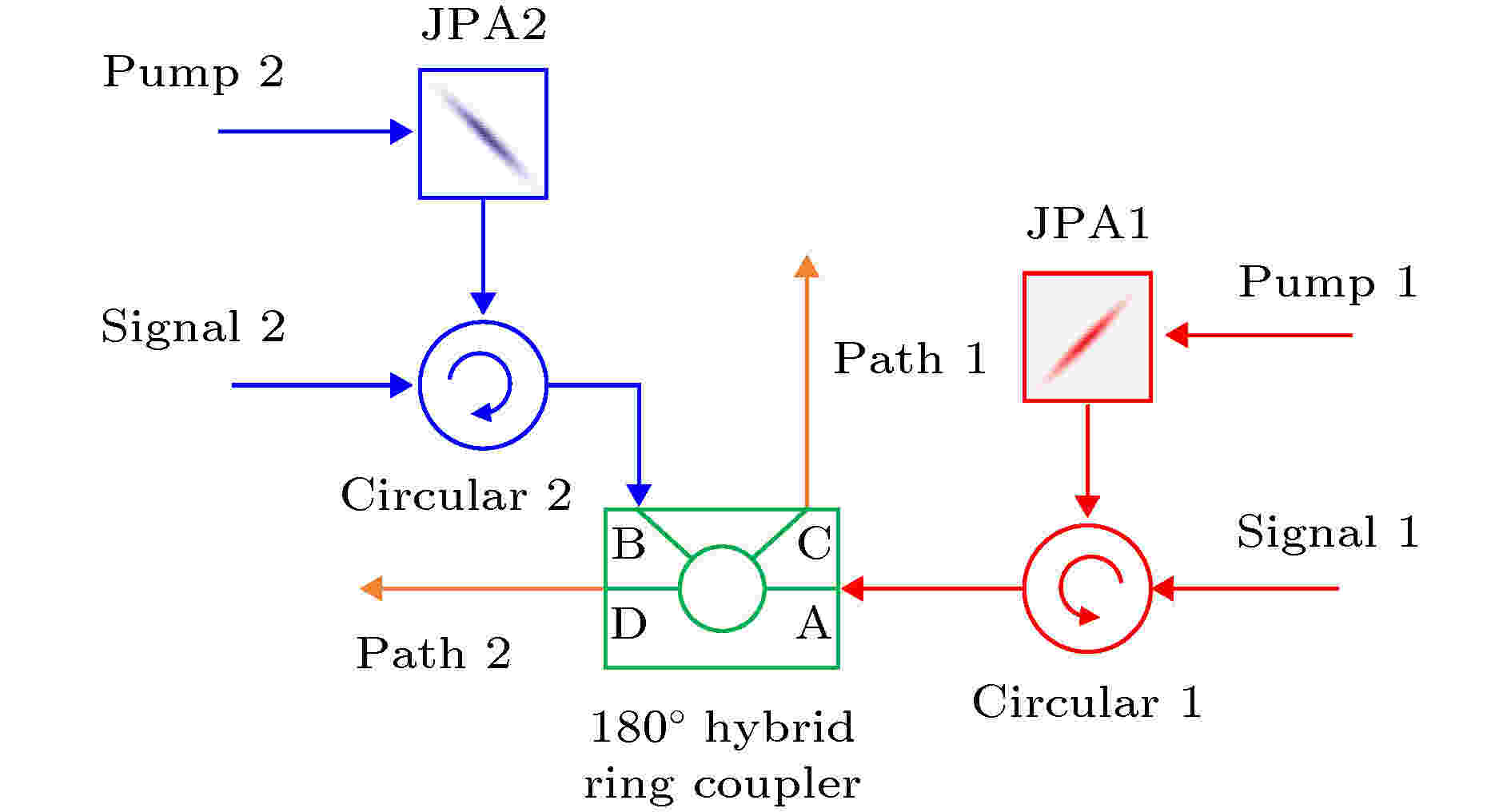
2020, 69 (3): 034204.
doi: 10.7498/aps.69.20191348
Abstract +
As the core of quantum entanglement, two-mode squeezing is manifested in cross-correlations of incompatible observables between two subsystems, which makes the two-mode squeezed microwave an ideal resource for applications in quantum communication, quantum illumination, and quantum microwave navigation. Currently the preparation scheme of two-mode squeezed microwave, based on the Josephson parametric amplifier (JPA) and a superconducting 180° hybrid ring coupler, proves to be the most efficient and excellent in quantum properties. Nevertheless, the difficult phase locking processing restricts the further improvement of entanglement. There is no effective solution but the dual-path receiver with phase stabilization measures, and the phase error reaches as high as 0.3°, which still does not meet the requirements for phase locking precision and entanglement stability. To overcome the academic obstacle, we propose a phase locking scheme to achieve a stable two-mode squeezed microwave. There are two JPAs used to separately generate single-mode squeezed microwaves, between which the difference lies in the fact that the input of one JPA is phase-modulated but the other is not. A superconducting 180° hybrid ring coupler is used to distribute the two single-mode squeezed microwaves into two output paths, which are two-mode squeezing if the squeezing directions of the two single-mode squeezed microwave are orthogonal. That is to say, the relative phase satisfies the condition $\theta = {\text{π}}/2$ . By mixing the unmodulated single-mode squeezed microwave and one output of the superconducting 180° hybrid ring coupler, a relative phase is obtained in subsequent process. Proportional integral derivative (PID) controller is used as the input of phase error, and the output is used to adjust the pump phase of JPA, which is the key to phase locking and stable two-mode squeezing. The present research not only provides an effective strategy to achieve stable two-mode squeezed microwave, but also may attract more attention to the precisive measurement of two-mode squeezed microwave.
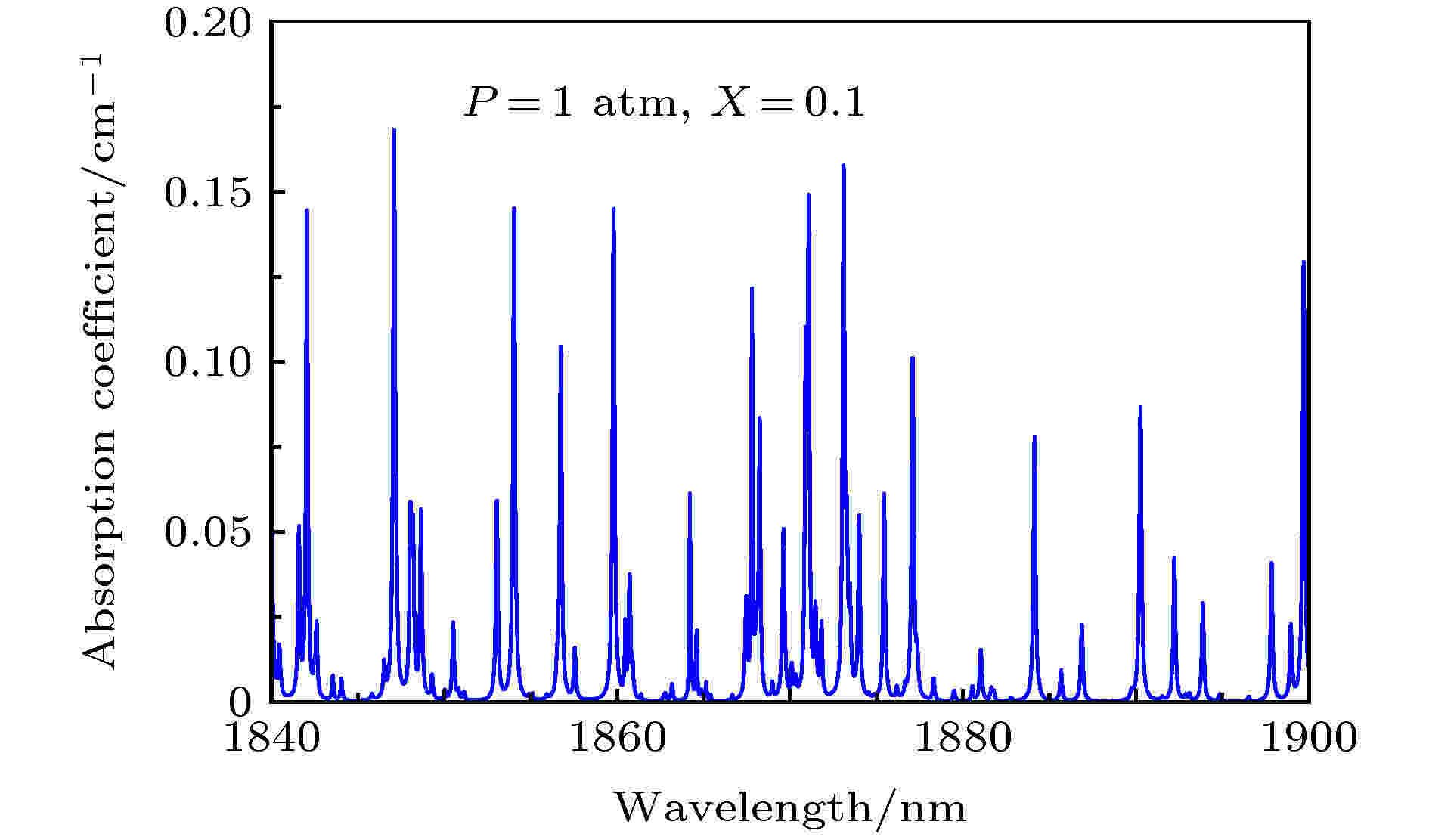
EDITOR'S SUGGESTION
2020, 69 (3): 034205.
doi: 10.7498/aps.69.20191515
Abstract +
Tunable diode laser absorption spectroscopy (TDLAS) is a widely used technology for measuring absorption spectrum. However, the measurement efficiency of TDLAS is greatly limited by the narrow tuning range of conventional tunable laser diode. Exploiting a wideband, narrow linewidth tuning laser source, hyperspectral absorption spectroscopy possesses the ability to provide the overall absorption information over a continuous waveband in a single scan, which would significantly improve the data volume and diagnostic capability of TDLAS. With profound and strong absorption lines of water and carbon dioxide, the 2 μm waveband is an ideal candidate for water and carbon dioxide related absorption spectrum. An absorption line recognition threshold of 0.07 nm is derived for the absorption spectrum measurement of water around 2 μm through theoretical analysis. Utilizing the wideband emission spectrum of Tm-doped fiber, a wideband tunable, narrow linewidth fiber laser operating at 2 μm is built by combining a tunable FP filter with a fiber saturable absorber. The tunable FP filter is responsible for the wavelength control of the laser system, with which a 60 nm wideband tuning range from 1840 nm to 1900 nm is achieved. With a section of Tm-Ho codoped fiber as the fiber saturable absorber which is used for linewidth compression, a static linewidth of 0.05 nm is attained. This wideband tunable, narrow linewidth fiber laser is tested for the hyperspectral absorption spectrum measurement of water around 2 μm. Drived with a 0–10 V triangle wave at a repetition rate of 50 Hz, the output spectrum of the laser spans over a wavelength range of about 30 nm from 1856 nm to 1886 nm. The laser beam propagates about 50 cm through an open air, and then enters into the detectors for direct measurement. The 35 absorption lines of water are recognized after processing the data. Within the 1870–1880 nm range, comparisons with the theoretical absorption spectra at different laser linewidths, derived from the HITRAN2012 absorption database, show that the measured data cannot effectively distinguish two absorption lines adjacent to the strong absorption line at 1873 nm and 1877 nm. And, the measured results can be best fitted to a laser linewidth of about 0.08 nm, demonstrating that in the dynamic scanning process, the linewidth of the laser is expanded beyond the absorption line recognition threshold. Thus, when operating in a fast wideband scanning mode, the laser system should further compress its linewidth.
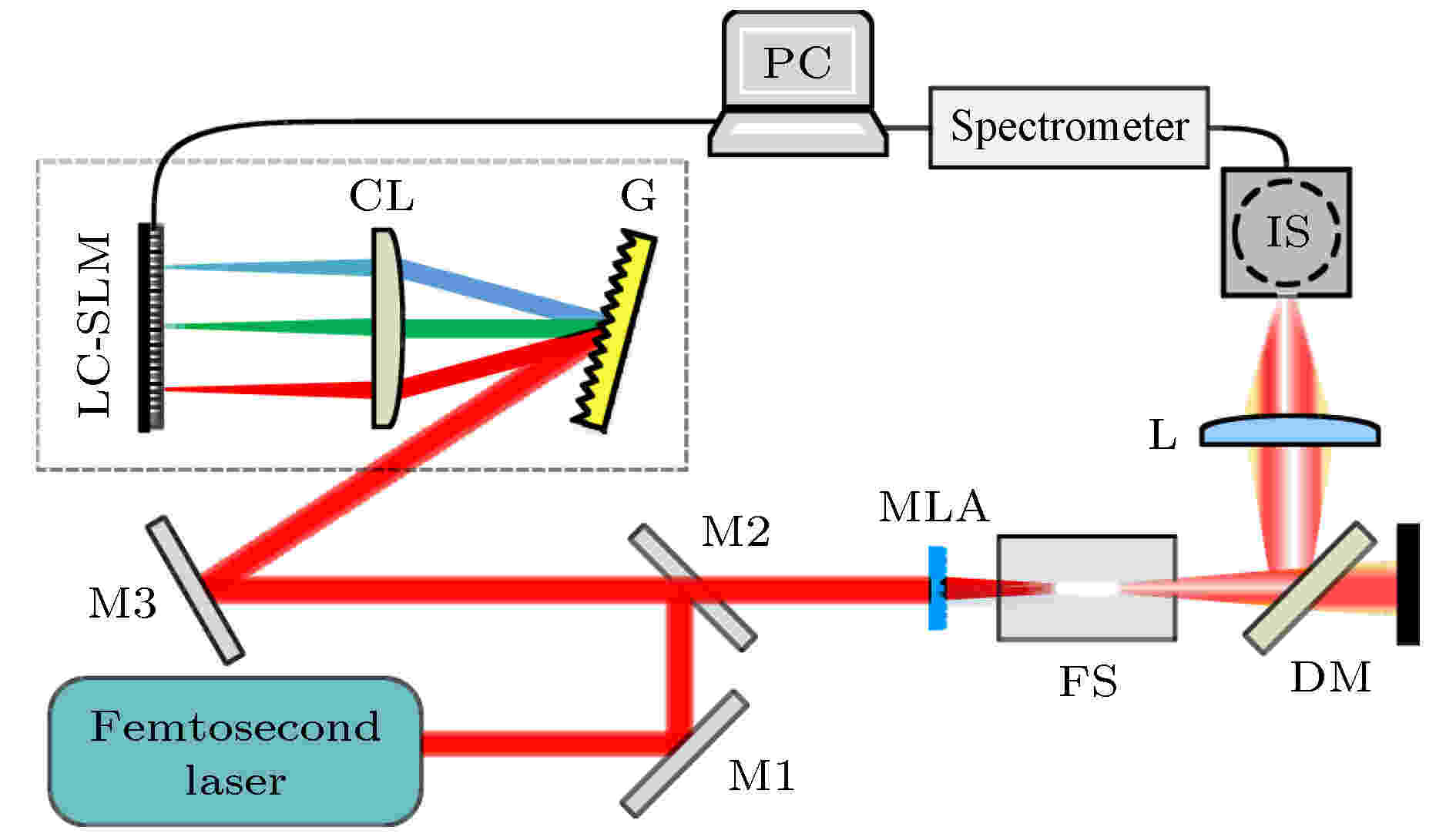
2020, 69 (3): 034206.
doi: 10.7498/aps.69.20191438
Abstract +
Supercontinuum (SC), as one of the most spectacular phenomena occurring in the nonlinear process of intense femtosecond laser-material interaction, has attracted considerable interest. The broadband SC sources have a variety of applications including the spectroscopy, fluorescence microscopy, remote sensing, and generation of few-cycle pulses. Over the last few decades, the SC has been extensively investigated in various optical media, including liquid, gas, and solid. Especially, ultrabroadband SC sources have achieved remarkable development in the photonic crystal and micro-structured fibers. Even so, the generation of the SC with high brightness, high spatiotemporal coherence and good maneuverability, is still a challenging topic. The SC generation from femtosecond filamentation is a unique white light source with high pulse energy, high brightness and high spatiotemporal coherence, whose spectral range spans from ultraviolet to mid-infrared. In recent years, numerous studies have been conducted to optimize the filamentation and SC. The control of filamentation such as the filament length, number and position, as well as the generation of the ultra-broadband spectrum with high spectral energy density has been realized. To date, the optimal control of SC has been realized by the spatial modulation or time-domain shaping of the femtosecond laser pulse. However, there is no report on the control of SC generation and filamentation by spatiotemporally modulating the femtosecond laser pulses as far as we know. In this work, a spatiotemporal modulation for the femtosecond laser pulse is proposed, which combines the spatial modulation by using microlens array (MLA) and the laser pulse shaping based on liquid crystal spatial light modulator. We investigate the control of the SC generation from the filamentation of the spatiotemporally modulated femtosecond laser pulses in fused silica by using the feedback optimal control based on genetic algorithm. In our experiments, with the increase of the iterative generation, the cut-off wavelength in the blue-side extension of the SC becomes shorter gradually, and the spectral intensity of the SC increases significantly. After the eighth iteration, the increase of the spectral intensity slows. With the number of iterations increasing further, the intensity and broadening of SC spectrum will no longer apparently change. Hence, the feedback optimization control of spectral intensity of SC is realized, and the SC with controllable spectral intensity in a certain range is obtained. The maximum intensity variation of SC is more than three times. By integrating the spectral intensities of SC for different iterative generations, we characterize the increase trend of SC conversion efficiency. During the first few iterations, the conversion efficiency increases rapidly. Then it increases slowly after eighth generations and reaches its maximum after several generations (10th generation). The conversion efficiency has a similar evolution to the spectral intensity of the SC. To explain the physical mechanism, the initial envelope of the shaping pulse with typical iteration generation is calculated. It can be concluded that the spatial modulation of MLA allows for higher incident laser energy and for more filaments’ generation, which increases the energy of SC radiation directly. The peak intensity and envelope distribution of time domain pulse are the main factors affecting the spectral intensity and broadening the SC.

2020, 69 (3): 034207.
doi: 10.7498/aps.69.20191333
Abstract +
The upconversion (UC) emission properties of rare-earth ions are not only dependent on the host materials, but also relate to the excitation conditions. In this work, taking the Ho3+ ions for example, upconversion emission properties are studied in two NaYF4 and LiYF4 fluoride microcrystals through changing excitation conditions, namely the excitation power and the sample environment. The NaYF4:20%Yb3+/2%Ho3+ and NaYF4:20%Yb3+/2%Ho3+ microcrystal are synthesized by the hydrothermal method. The typical X-ray diffraction patterns of NaYF4:20%Yb3+/2%Ho3+ and LiYF4:20%Yb3+/2%Ho3+ microcrystal indicate that the prepared samples possess pure hexagonal phase NaYF4 structure and the pure tetragonal phase LiYF4 structure with high crystallinity, respectively. Most of NaYF4:20%Yb3+/2%Ho3+ microcrystals show uniform and regular rod shape with diameter and length of approximately 3 μm and 10 μm, respectively. Few rods with a length of approximately 5 μm are also observed. The LiYF4:20%Yb3+/2%Ho3+ microcrystals are all octahedral in shape with a smooth surface, the average size is around 10 μm. The spectral peculiarities of Ho3+ are investigated by using confocal microscopy equipment under near infrared 980 nm excitation. Beautiful patterns with different upconversion emissions of Ho3+ are discovered in single NaYF4 and LiYF4 microcrystal. As the excitation power increases, the upconversion emission of Ho3+ turns from green to pink in single NaYF4 microrods due to the cross-relaxation between Ho3+ and the energy back transfer from Ho3+ to Yb3+. However, in single LiYF4:Ho3+ microcrystal no similar phenomenon is observed. Nevertheless, when the powder of NaYF4 and LiYF4 microcrystals are excited by a 980 nm laser, increasing the power can turn the output colours of Ho3+ all green. Because particles outside the laser radiation are not directly covered by the laser, most of them are excited by the scattered light from the laser, and the actual excitation energy is low compared with at the center position. This result can be proved in the single NaYF4 and LiYF4 microcrystal under low excitation power. Thus, the results indicate that UC emission of rare-earth ions is controlled by changing the excitation condition. Using the new testing methods we can not only observe more interesting spectral phenomena, but also find a new way to further study its luminescence mechanism.
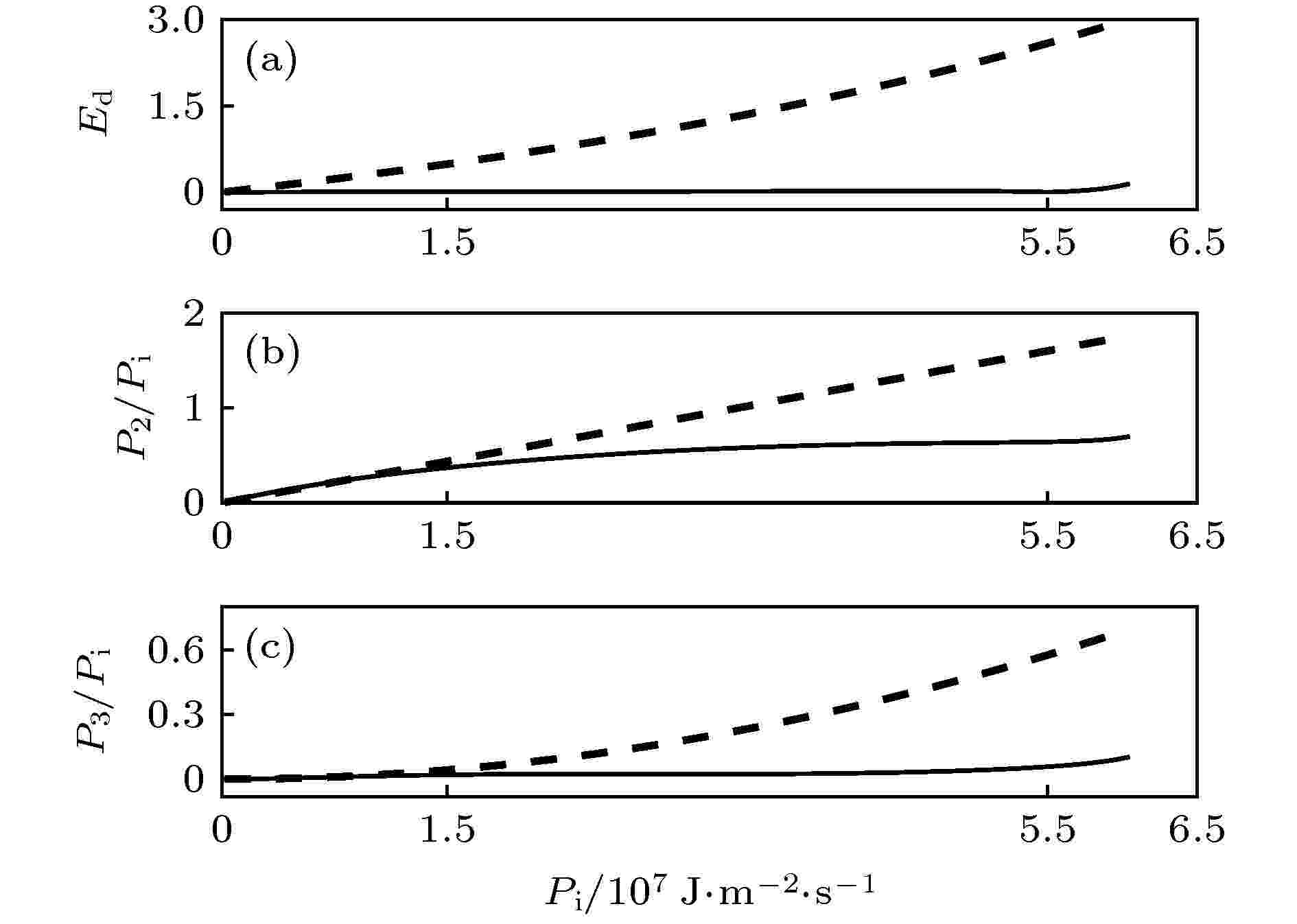
2020, 69 (3): 034301.
doi: 10.7498/aps.69.20191440
Abstract +
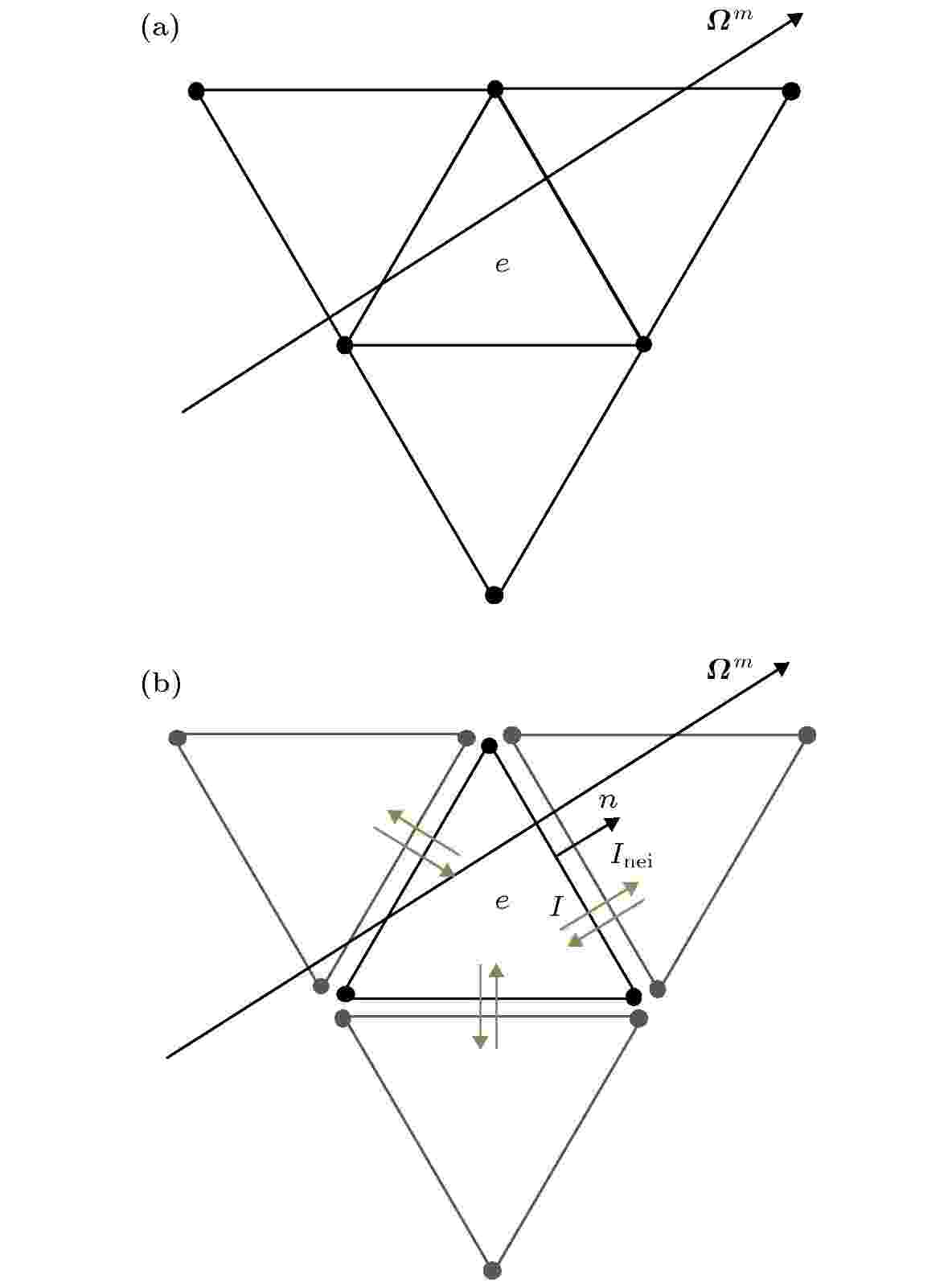
2020, 69 (3): 034401.
doi: 10.7498/aps.69.20191185
Abstract +
The discontinuous finite element method (DFEM) is used to investigate the coupled radiation-conduction heat transfer in an irregular medium, and the highly accurate solutions for several typical media are numerically obtained. Comparing with the traditional continuous finite element method, the computational domain in the DFEM application is discretized into unstructured meshes that are assumed to be separated from each other. The shape function construction, field variable approximation, and numerical solutions are obtained for every single element. The continuity of the computational domain is maintained by modeling a numerical flux with the up-winding scheme. Thus the DFEM has the salient feature of geometry flexibility and simultaneously supports locally conservative solutions. The DFEM discretization for the radiative transfer equation and the energy diffusion equation are first presented, and the accuracies of the DFEM for coupled radiation-conduction heat transfer problems are verified. Combined radiation-conduction heat transfer problems in several irregular media are afterward solved, and the highly accurate DFEM solutions are presented.
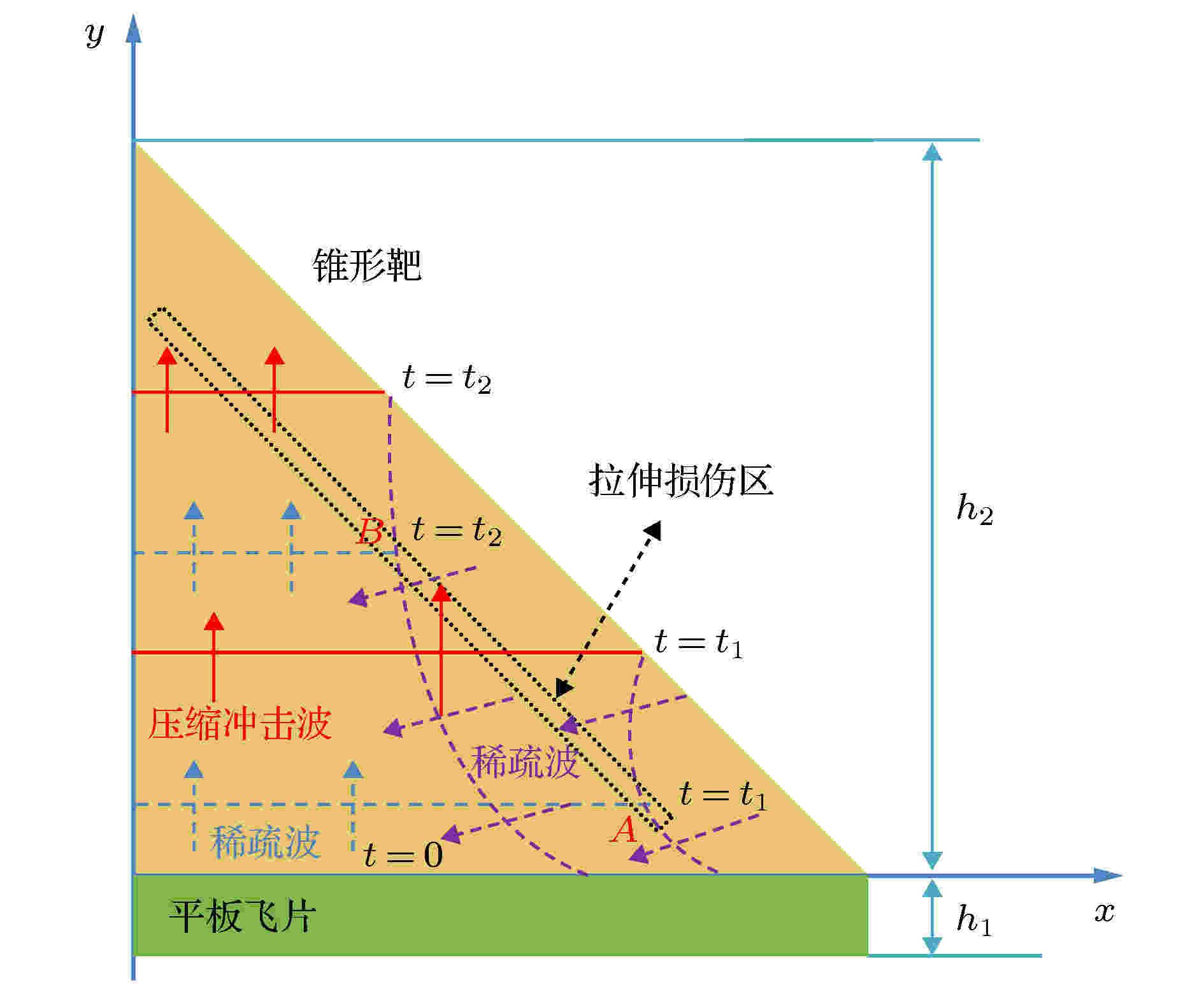
2020, 69 (3): 034601.
doi: 10.7498/aps.69.20191104
Abstract +
A new spallation experimental method by using conical target is proposed. Based on the analysis of wave propagation, the basic principle of spallation experiment of conical target is discussed. Then incipient spallation of high purity (HP) copper under non-one-dimensional strain shock wave is studied experimentally by using a gas gun setup. The damage distribution characteristics and micro-mechanism of conical HP copper target are analyzed. The intrinsic relationship between the characteristics of free surface velocity profiles and damage evolution is explored. The results indicate that 1) continuous damage zones including different damage states appear in the conical HP copper target with initial spallation from the bottom of cone to the top of cone along the direction parallel to the cone surface, which is attributed to the spatial evolution of the amplitude and duration time of tensile stress in the conical target; 2) quantitative statistical analysis of damage inside conical HP copper target reveals that the nucleation and early growth of micro-voids are random, while the coalescence of micro-voids has significant localization characteristics; 3) the normal free surface particle velocity profiles with typical pull-back spallation signals at different locations of conical HP copper target are measured by multi-channel photon Doppler velocimetry. Comparing with the damage distribution characteristics, it is revealed that the spallation strength based on pull-back velocity is independent of damage, and is the critical nucleation stress of micro-voids. But the slope and amplitude of pull-back rebound velocity depend on damage evolution process, which relates to the change of damage evolution rate and stress relaxation caused by damage degree respectively.
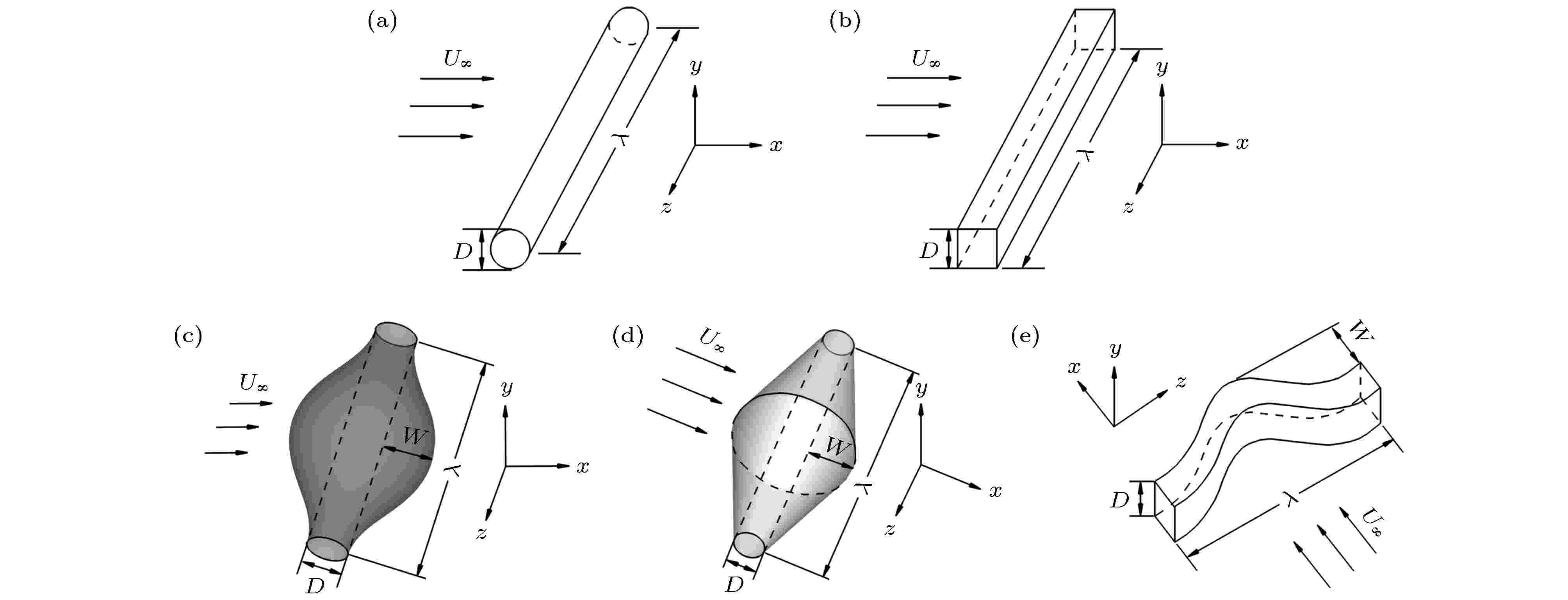
EDITOR'S SUGGESTION
2020, 69 (3): 034701.
doi: 10.7498/aps.69.20191011
Abstract +
Bluff bodies possess many engineering applications. The flow past a bluff body is a classical issue in fluid mechanics. In most of previous studies, the role of streamwise vorticity is mainly stressed in three-dimensional wake flow, such as in the physical origin of streamwise vortices in the mode A, and the complete suppression of alternatively shedding Kármán vortices under the effect of geometric disturbances introduced in the bluff body. However, through the careful investigation of two examples above, the vertical vorticity actually plays a key role. Furthermore, there is a physical phenomenon, special relationship among dominant vorticity components with specific signs or vorticity sign law, occurring in the wake of a bluff body with geometric disturbances. In the present paper, through direct numerical simulations at low Reynolds numbers, such a phenomenon is summarized in two kinds of cylinders, i.e. basic straight cylinder and geometrically disturbed cylinder. Two typical cross-sections are examined, including the circular and square sections. Three sub-regimes (front surfaces, shear layers and wake) are mainly investigated. The numerical results show that two generalized vorticity sign laws exist in the wake of a bluff body. For example, the first sign law shows that the sign of streamwise vorticity is always the same as that of vertical vorticity in the upper shear layer, but opposite in the lower shear layer. The second sign law shows that the sign combination of three components of vorticity is always negative in the shear layers and wake. As for the physical mechanism of sign laws appearing in the present two kinds of cylinders, the main difference between the small perturbance which induces the natural three-dimensional instability and the geometric disturbance leads to the evolution of generated surface vorticity under the effect of inertial forces. These generalized sign laws have been already verified theoretically in the previous work recently. Moreover, sign laws also indicate that the different vortex-shedding patterns in the wake of different bluff bodies are inherently identical from the point of vorticity sign. Considering the physical fact that the wall is the only source of new vorticity in the present vortex dynamics, the theoretical results also indicate that the Π-type vortex with specific groups of vorticity components is a basic vortex pattern generated on the walls, once the three-dimensional wake first appears in the wake at low Reynolds number.
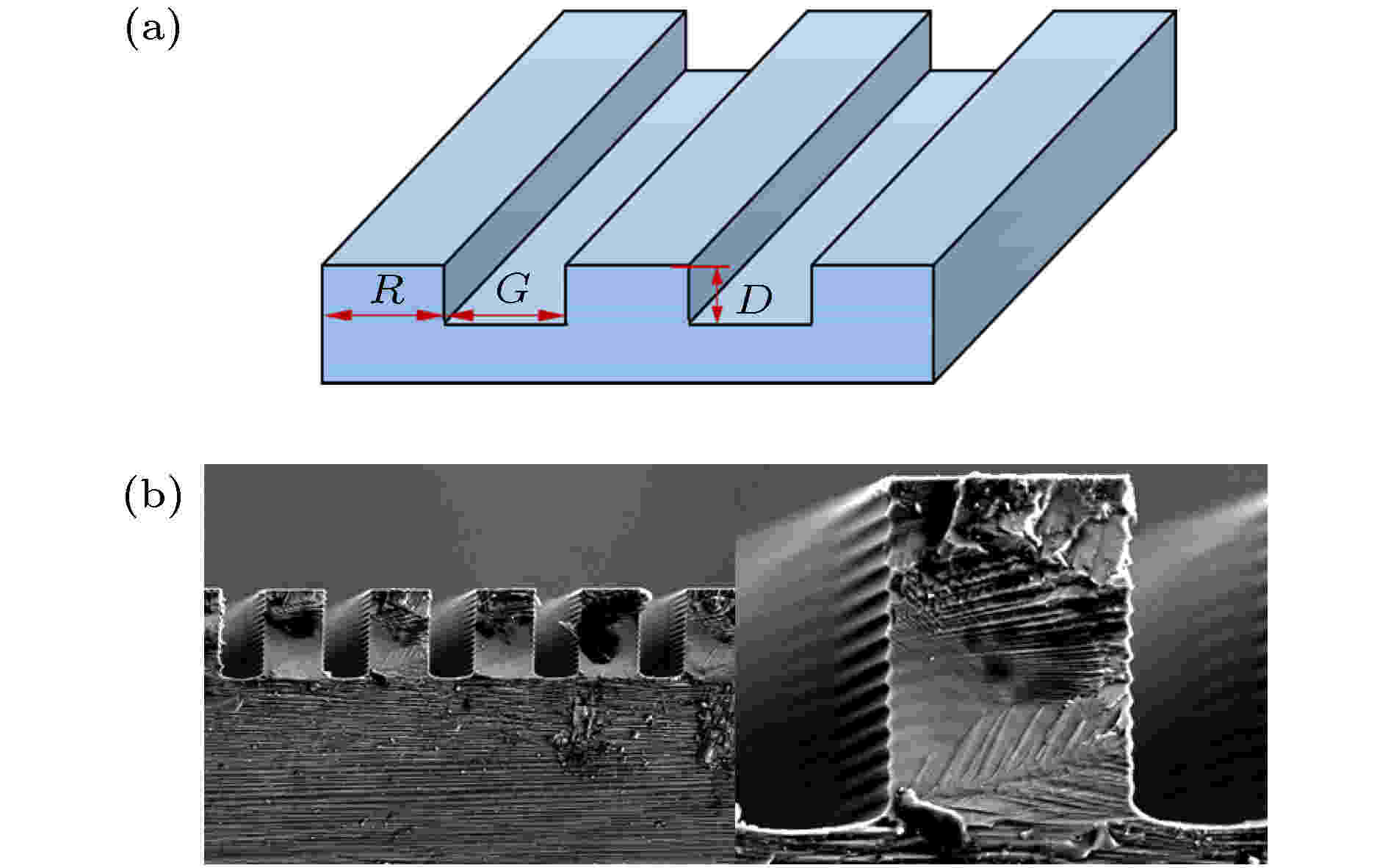
2020, 69 (3): 034702.
doi: 10.7498/aps.69.20191429
Abstract +
Biomimetic microstructure has been used widely in the fields of microfluidics, micro-mixers, flow drag reduction, tribology, etc. When solid surface is modified with microstructure, it will inevitably influence the solid-liquid interfacial behaviors, such as adhesion, surface wetting, shear viscous resistance, and interfacial slip. Surface anisotropic wetting can be achieved by using either of anisotropic surface microstructure and chemically heterogeneous patterned surface, or both of them. And anisotropic wetting properties can be used to control the micro-flowing behaviors, like mixing, flowing direction and speed. The effect of microstructure on the surface wetting behavior is closely related to the size, shape and arrangement of microstructure. In the paper, the influence of micro-groove size on liquid anisotropic wetting behavior is studied. The results indicate that the droplet wetting state of the patterned surface used is Cassie state. According to the experimental results, we can see that the liquid flows easily along the groove direction with small motion resistance, thus resulting in a small contact angle. While the water droplet has a higher flowing resistance in the direction perpendicular to the groove direction due to the energy barrier caused by micro-groove, thus showing a larger contact angle. Meanwhile, the water droplet shows pinning and jump behavior during the spreading in the direction perpendicular to the micro-groove direction. The contact angle along the micro-groove direction θ// increases with groove width G increasing, and decreases with ridge width R increasing, which means that the parallel direction contact angle θ// is inversely proportional to the solid fraction R/(R + G). And the experimental contact angle θ// shows good consistence with that obtained from theoretical Cassie model. While the contact angle of water droplet perpendicular to groove direction θ⊥ almost keeps no change with groove width G nor ridge width R. Both the droplet deformation ratio L/W and contact angle ratio of the two featured direction θ⊥/θ// are proportional to the solid fraction R/(R + G). The water droplet shows anisotropic wetting behaviors, which means that the liquid motion resistances are different in these directions. The high droplet deformation ratio L/W and the high contact angle ratio θ⊥/θ// correspond to the large difference in motion resistance. And surface wetting behavior has a great influence on the micro-flowing behavior. Thus, the micro-flowing behavior can be regulated by changing the microgroove size. The present research can conduce to the understanding the wetting mechanism and flowing behaviors of liquid droplet on patterned surface.
PHYSICS OF GASES, PLASMAS, AND ELECTRIC DISCHARGES
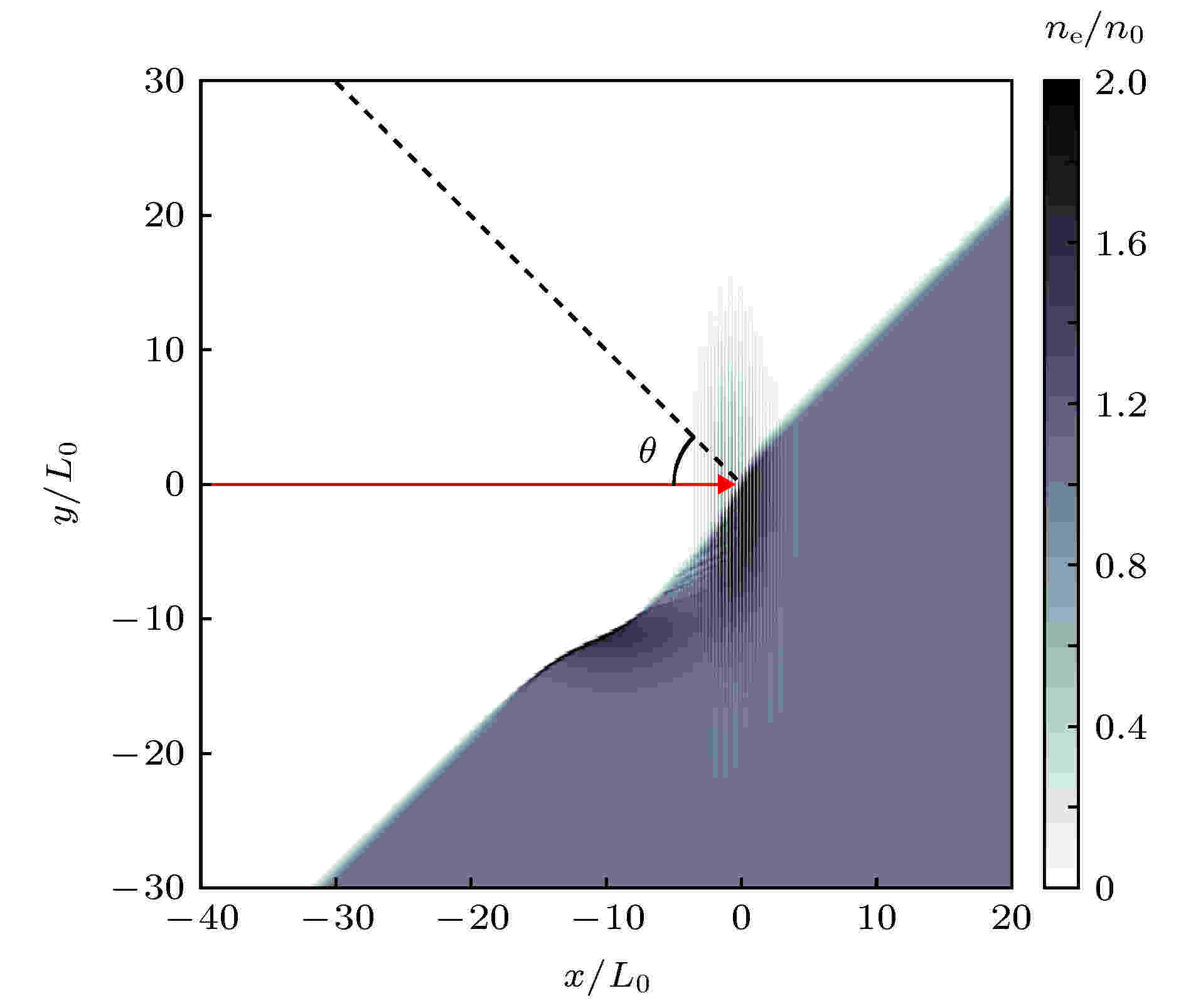
2020, 69 (3): 035201.
doi: 10.7498/aps.69.20191332
Abstract +
Plasma wakefield acceleration driven by ultra short ultra intense laser pulse interacting with gas target has been studied for almost four decades. Monoenergetic electron beams with central energy of multi-giga electron-volt have been achieved in a centimeter-scale acceleration distance. Currently, the highest energy of electrons accelerated by laser wakefield is 8 GeV. In order to further improve the quality of such electrons, many kinds of electron injection schemes have been proposed such as density gradient injection, colliding pulse injection and ionization injection. Electrons under the suitable conditions can be trapped by the strong plasma wakefield. Those trapped electrons are then accelerated in the wakefield. In a nonlinear regime, the wakefield shows a “bubble” structure. Electrons with transverse momentum can oscillate in the wakefield and produce considerably betatron radiation in the ultraviolet and X-ray region. In this paper, we study the electron injection around the sharp plasma-vacuum boundary. The effects of the slant angle of the boundary on the final electron quality are investigated in detail. Our results show that with optimal slant density transition around the vacuum plasma boundary, both the beam quality and the injection charge in the second “bubble” can be improved. Two-dimensional particle-in-cell simulations show that the injection charge in the second wake bucket can be increased three times when an optimal slant angle is used compared with a vertical boundary. The driving pulse’s polarization also affects the injection charge. When the polarization is in the injection plane the injection charge in the first bucket can be triply increased compared with the case when the polarization is out of the plane. The reasons for the enhanced injection charge and transverse oscillation are found by tracing the initial injection positions and trajectories of the electrons. These studies would benefit the electron acceleration and its applications, such as compact betatron radiation source.
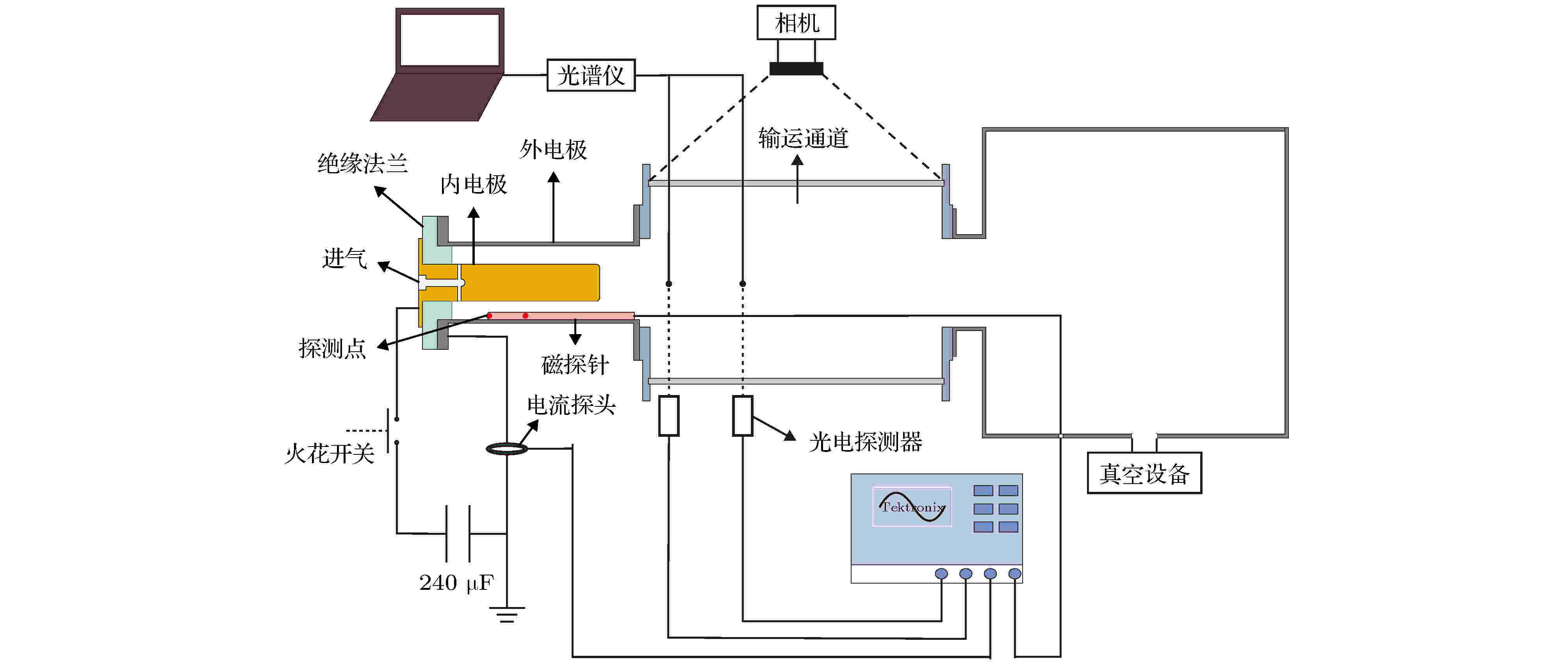
2020, 69 (3): 035202.
doi: 10.7498/aps.69.20191321
Abstract +
The coaxial gun plasma generated by pulsed discharge possesses the characteristics of high speed and high density, and has potential application value in the field of fusion, space propulsion and astrophysics. In this paper, the effect of positive and negative pulsed discharges on plasma characteristics are investigated and a theoretical model for analyzing the morphology of positive and negative pulsed current sheets is proposed. Positive and negative pulsed discharges are realized by changing the direction of the rectifier diode in the pulse power supply to change the direction of the recharging current. Through theoretical analysis, and measurements by using photodiode, Pearson probe, magnetic probe, HD camera, fast-framing camera and RGB image processing, the plasmas generated by positive and negative pulsed discharges are compared and investigated. Most of experimental diagnoses concentrate on investigating the plasma behavior in the coaxial gun muzzle on a microsecond-order time scale. Because radial and axial transport characteristics of plasma change little, we think, the plasma characteristics in the muzzle still depend on the characteristics of plasma in the coaxial gun. Therefore, the conclusion of the theoretical analysis of the current sheet in the coaxial gun is still valid for the plasma in the muzzle. The theoretical analysis shows that the positive pulsed current sheet presents a parabolic shape and the negative pulsed current sheet displays a convex shape, which makes the negative pulsed current sheet sweep more efficiently and a large amount of plasma is concentrated near the inner electrode, namely the cathode, so the negative pulsed plasma is denser. For the positive pulsed plasma, near the inner electrode the plasma is thin and the magnetic pressure is powerful, and near the outer electrode, the plasma is dense and the magnetic pressure is weak. Therefore, the positive pulsed plasma is faster in movement speed but easier to split, and because of its dispersion, its transport stability is not so good as that of the negative pulsed plasma. The experimental results accord with the theoretical analyses. The final conclusion shows that under the same discharge parameters, the positive pulsed discharge produced plasma is faster in movement speed but more likely to split, and the negative pulsed discharge created plasma is denser in density and more stable. Therefore, for obtaining a higher density plasma, the negative pulsed discharge is recommended, and for achieving a high-speed plasma source, the positive pulsed discharge is advised to be adopted.

2020, 69 (3): 035203.
doi: 10.7498/aps.69.20191411
Abstract +
Magnetized liner inertial fusion (MagLIF) integrates the advantages of traditional magnetic confinement fusion with those of inertial confinement fusion, and thus has promising potentials because theoretically it can dramatically lower the difficulties in realizing the controlled fusion. For the systematic simulating of MagLIF, we build up an integrated one-dimensional (1D) model to describe the complex process, which includes the terms of magnetization, laser preheating, liner implosion, fusion reaction, end loss effect, and magnetic flux compression. According to this model we develop an integrated 1D code–MIST (magnetic implosion simulation tools) , and specifically we propose a simplified model to describe the end loss effect based on the flow bursting theory, so the code is able to consider two-dimensional effects within 1D calculations. We also present a specific expression of magnetic diffusion equation where the Nernst effect term is taken into consideration, which is very important if there exists a temperature gradient perpendicular to magnetic field lines. Such conditions are fully satisfied in the MagLIF process. We use experimental data of aluminum liner implosions to verify the magneto-hydrodynamic module of our code, those shots (0607 & 0523) are performed on FP-1 facility (2 MA, 7.2 μs), and results show good agreement with the calculated velocity of inner flyer or target surface and other measurements. Comparison with code LASNEX and HYDRA (used by Sandia Laboratory) is also made to assess the fusion module, and the results show that our calculations are physically self-consistent and roughly coincide with the results from LASNEX and HYDRA, a key difference appears at fuel temperature, and the factors that might cause this difference are discussed. With this integrated model and 1D code, our work would provide a powerful tool for the future experimental research of MagLIF.

2020, 69 (3): 035204.
doi: 10.7498/aps.69.20191423
Abstract +
When evaluating the plasma parameters in inertial confinement fusion, the flux-limited local Spitzer-Härm (S-H) model in radiation hydrodynamics simulations may be invalid when electron temperature gradient is too large. In other publications, the electron distribution function (EDF) could be explained by comparing the energy equipartition rate $R_{\rm eq}=\dfrac{1}{2}m_{\rm e}v_{\rm te} ^2\nu_{\rm ee}$ with the heating rate $R_{\rm heat}=\dfrac{1}{2}m_{\rm e}v_{\rm os} ^2\nu_{\rm ei}$ . When the condition $R_{\rm heat}\sim R_{\rm eq}$ is satisfied, the EDF deviates from Maxwell equilibrium distribution, and is well fitted to the super-Gaussian distribution $f({{ v}})=C_m{\rm e}^{-(v/v_m)^m}$ with the index m ($2<m<5$ ). The number of energetic electrons of the super-Gaussian distribution is less than that of the Maxwell distribution, which plays an important role in electron heat flux, especially for electrons of 3.7$v_{\rm te}$ . So electron heat flux of the super-Gaussian distribution is smaller than that of the Maxwell distribution. In this paper, EDF and electron heat flux in laser-produced Au plasma are simulated by using 1D3V PIC code (Ascent). It is found that in the coronal region, the laser intensity is larger, and the electron temperature is lower than the high-density region. So $\alpha=Z(v_{\rm os}/v_{\rm te})^2>1$ , $R_{\rm heat}>R_{\rm eq}$ , the EDF is well fitted to super-Gaussian distribution, where the index m is evaluated to be 3.34. In this region, the large electron temperature gradient leads to a small temperature scale length ($L_{\rm e}=T_{\rm e}/(\partial T_{\rm e}/\partial x)$ ), but the low e-e and e-i collision frequencies lead to a large electron mean-free-path ($\lambda_{\rm e}$ ). So the Knudsen number $\lambda_{\rm e}/L_{\rm e}$ is evaluated to be 0.011, which is much larger than the critical value $2\times10^{-3}$ of the S-H model, flux-limited local S-H electron heat flux is invalid. As a result, the limited-flux S-H predicts too large an electron heat flux, which results in much higher electron temperature of radiation hydrodynamics simulation than that of SG experiments. This heat flux inhibition phenomenon in coronal region cannot be explained by the flux-limited local S-H model, and non-local electron heat flux should be considered. In the high density region, the laser intensity is weaker, and the electron temperature is higher, so $\alpha=Z(v_{\rm os}/v_{\rm te})^2<1$ , $R_{\rm heat}<R_{\rm eq},$ but EDF is still well fitted to super-Gaussian distribution, where the index m is evaluated to be 2.93. In this region, $L_{\rm e}$ is larger, $\lambda_{\rm e}$ is smaller, so the Knudsen number is smaller, which is evaluated to be $7.58\times10^{-4}<2\times10^{-3}$ . As a result, The flux-limited local S-H electron heat flux is valid. However, the electron heat flux depends on the flux limiting factor ($f_{\rm e}$ ) that varies with laser intensity and electron temperature.
CONDENSED MATTER: STRUCTURAL, MECHANICAL, AND THERMAL PROPERTIES

2020, 69 (3): 036101.
doi: 10.7498/aps.69.20191379
Abstract +
Formation and evolution of interstitial dislocation loop induced by radiation damage in a material are confirmed to seriously affect the performance of the material under irradiation. For example, in body-centered cubic Fe based alloy, 1/2$\left\langle 111 \right\rangle $ and $\left\langle 100 \right\rangle $ are mainly formed during the irradiation, which is related to various degradations of material properties. Thus, the understanding of their effect on radiation damages of material is always one of the hottest topics in nuclear material society. Previous studies have shown the surface effect on 1/2$\left\langle 111 \right\rangle $ loop through the investigation of the interaction between 1/2$\left\langle 111 \right\rangle $ loop and {111} surface. Considering the difference in property between 1/2$\left\langle 111 \right\rangle $ loop and $\left\langle 100 \right\rangle $ loop, in this work the interaction between a $\left\langle 100 \right\rangle $ loop and {100} surface is studied in detail through the molecular dynamics method. The simulation results indicate that the factors including Burgers vector of loop, loop-to-surface depth, interaction between pre-existing $\left\langle 100 \right\rangle $ loops, and temperature, all seriously affect the interaction between loop and surface. Especially, the present results show for the first time the evolution of Burgers vector of $\left\langle 100 \right\rangle $ loop from $\left\langle 100 \right\rangle $ to 1/2$\left\langle 111 \right\rangle $ and its one-dimensional diffusion to surface. According to these results, we also further explore the surface evolution after its interaction with loop. The appearance of atomic island results in the rugged surface morphology. All these results provide a new insight into the radiation damage to the surface of material.
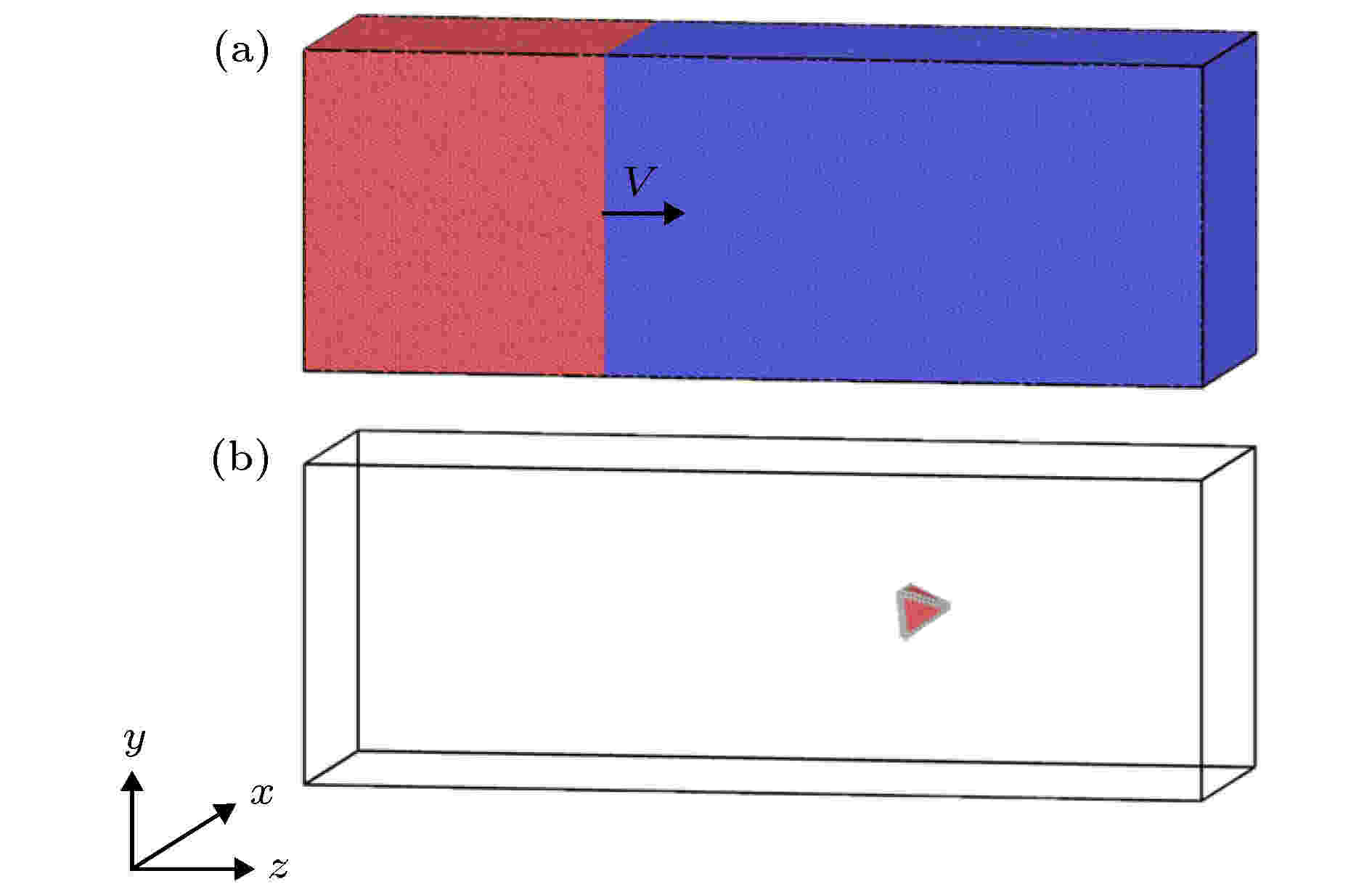
2020, 69 (3): 036201.
doi: 10.7498/aps.69.20191425
Abstract +
Stacking fault tetrahedron (SFT) is a common type of three-dimensional vacancy clustered defect in irradiated FCC metals and alloys, which has a great influence on the mechanical properties of the materials. Previous researches mostly concentrated on the effect of SFT on the mechanical response of material under quasi-static or constant strain rate loading condition, while very few studies focused on its influence on mechanical properties under the shock loading condition. Spallation is a typical failure mode of ductile metal material under shock loading, and the initial defects in the material have a great influence on the spallation behavior. In this study, molecular dynamics simulation is carried out to investigate the influence of SFT on spallation behavior of irradiated copper single crystal under different shock intensities. Copper single crystal with a perfect structural model is also investigated under the same simulation condition for comparison. The model is divided into two parts: the flyer and the target. The shock wave is generated by moving the flyer at a velocity in a range of 1.0–2.5 km/s along the [111] crystallographic orientation to achieve the desired shock-state particle velocity Up in a range of 0.5–1.25 km/s. The time evolution of pressure, free surface velocity and corresponding microstructure, are analyzed in detail to illuminate the spallation behavior of the Cu with SFT. It is revealed that the SFT collapses during shock compression and induces the generation of dislocations and stacking faults in the material. Subsequently, spallation happens when the voids nucleate and grow in the region of dislocations and stacking faults. Moreover, the materials show different spallation behaviors at different shock intensities. When Up ≤ 1.0 km/s, only elastic deformation occurs in perfect single crystal copper under shock compression, but in the copper with SFT, local defects appear and plastic deformation occurs due to the collapse of SFT under shock compression. The influence of SFT on spallation is most pronounced at a medium shock intensity. When Up = 0.75 km/s, the local defects caused by the collapse of SFT provide a wider nucleation area for the voids and promote the heterogeneous nucleation of the voids, resulting in the decreasing of the spall strength. The void nucleation of single crystal copper with SFT is found to be much later than the perfect one and the rate of spall damage evolution also decreases due to energy dissipation during SFT’s collapse and plastic deformation. When Up increases to 1.25 km/s, shock compression induces many defected atoms in both samples, so the SFT has little influence on the spall strength and spall damage of the materials.
CONDENSED MATTER: ELECTRONIC STRUCTURE, ELECTRICAL, MAGNETIC, AND OPTICAL PROPERTIES
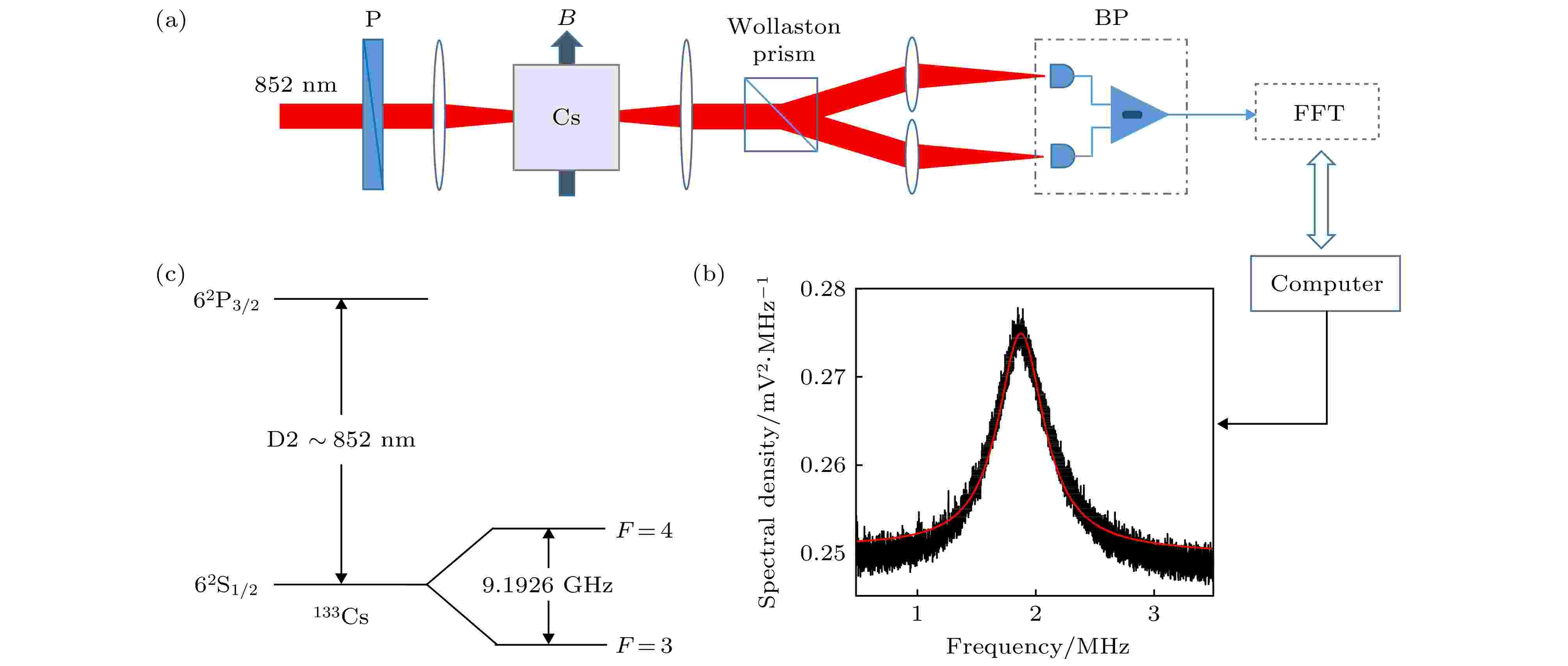
EDITOR'S SUGGESTION
2020, 69 (3): 037201.
doi: 10.7498/aps.69.20191623
Abstract +
In this paper, the spin dynamics and broadening mechanism of cesium vapor in cells without buffer gas is investigated by means of spin noise spectroscopy. In a macro atomic vapor cell, the lineshape of detuning frequency spectrum of spin relaxation rate is of Gaussian distribution. For a micron-scaled vapor cell with strong spatial locality, the lineshape of detuning frequency spectrum of spin relaxation rate is of Lorentzian distribution. The parameter dependence of detuning frequency spectrum of spin relaxation rate, such as temperature, is studied quantitatively. The detuning frequency spectrum of the spin relaxation rate is measured experimentally to be broadened by $ \sim $ 4 GHz, which is obviously larger than the unhomogeneous Doppler broadening of $ \sim $ 500 MHz for a macro atomic vapor cell. At the same time, the detuning frequency spectrum of total noise in the two atomic vapor cells is studied. In the macro atomic vapor cell, the total noise intensity strongly relies on the detuning frequency of the laser with respect to the atomic resonance transition. In the micron-scaled vapor cell, due to the strong homogeneous broadening, the center of the detuning frequency spectrum of the total noise is observed to dip. Finally, a simplified physical model is established to compute the broadening of the micron-scaled vapor cell. The homogeneous broadening of atoms is explained experimentally and theoretically in the micron-scaled vapor cell.

2020, 69 (3): 037901.
doi: 10.7498/aps.69.20191496
Abstract +
Nowadays, the output power and lifetime of a single magnetron are far from the requirements of industrial applications. So the new materials and methods are urgently needed to enhance the output power and prolong the lifetime of the magnetron. As the heart of a magnetron, cathode, whose quality directly affects the output power and lifetime of the magnetron, plays an important role. In order to enhance the output power and prolong the lifetime of the high power magnetron, a method of doping rare earth oxide Y2O3 into transition metal oxide HfO2 is used to prepare Y2Hf2O7 ceramic cathode. The thermionic emission and lifetime characteristics of the Y2Hf2O7 cathode are measured. The results show that the cathode can provide 0.15, 0.2, 0.5, 1.1, 1.8, 2.5, 3.5 A/cm2 current density for the space charge limitation at 1300, 1350, 1400, 1450, 1500, 1550, 1600 ℃br under 300 V anode voltage, respectively. Absolute zero work function of the cathode is only 1.26 eV obtained by the Richardson line method. The effective work function of the cathode is 3.10, 3.15, 3.21, 3.26 eV obtained by the Richardson-Dushman formula at 1450, 1500, 1550, 1600 ℃br respectively. The lifetime of the cathode is more than 4000 h under an initial load of 0.5 A/cm2 at 1400 ℃br, the lifetime which is much longer than the 2000 h average life span for the 2450 MHz continuous wave magnetron cathode used in production. Finally, the molecular structure, surface microstructure, element composition and content of the Y2Hf2O7 ceramic cathode are analyzed by the X-ray diffraction, scanning electron microscope, energy dispersive spectrometer, Auger electron spectroscopy with argon ion etching respectively. The analysis results show that the single Y2Hf2O7 phase forms under the high sintering temperature. When the Y3+ valence Y2O3 is doped into the Hf4+ valence HfO2, the substitutional solid solution will form. An oxygen vacancy is generated in the lattice, thus maintaining the electrical neutrality of the Y2Hf2O7 lattice. During the cathode activating, aging, and thermally testing, the oxygen vacancy is generated fast. The more the obtained oxygen vacancies, the higher the conductivity of the cathode surface will be. Besides, due to the improvement of the electro-conductivity thus enhancing the thermionic emission capability of the cathode, the work function of the cathode can be reduced.
INTERDISCIPLINARY PHYSICS AND RELATED AREAS OF SCIENCE AND TECHNOLOGY
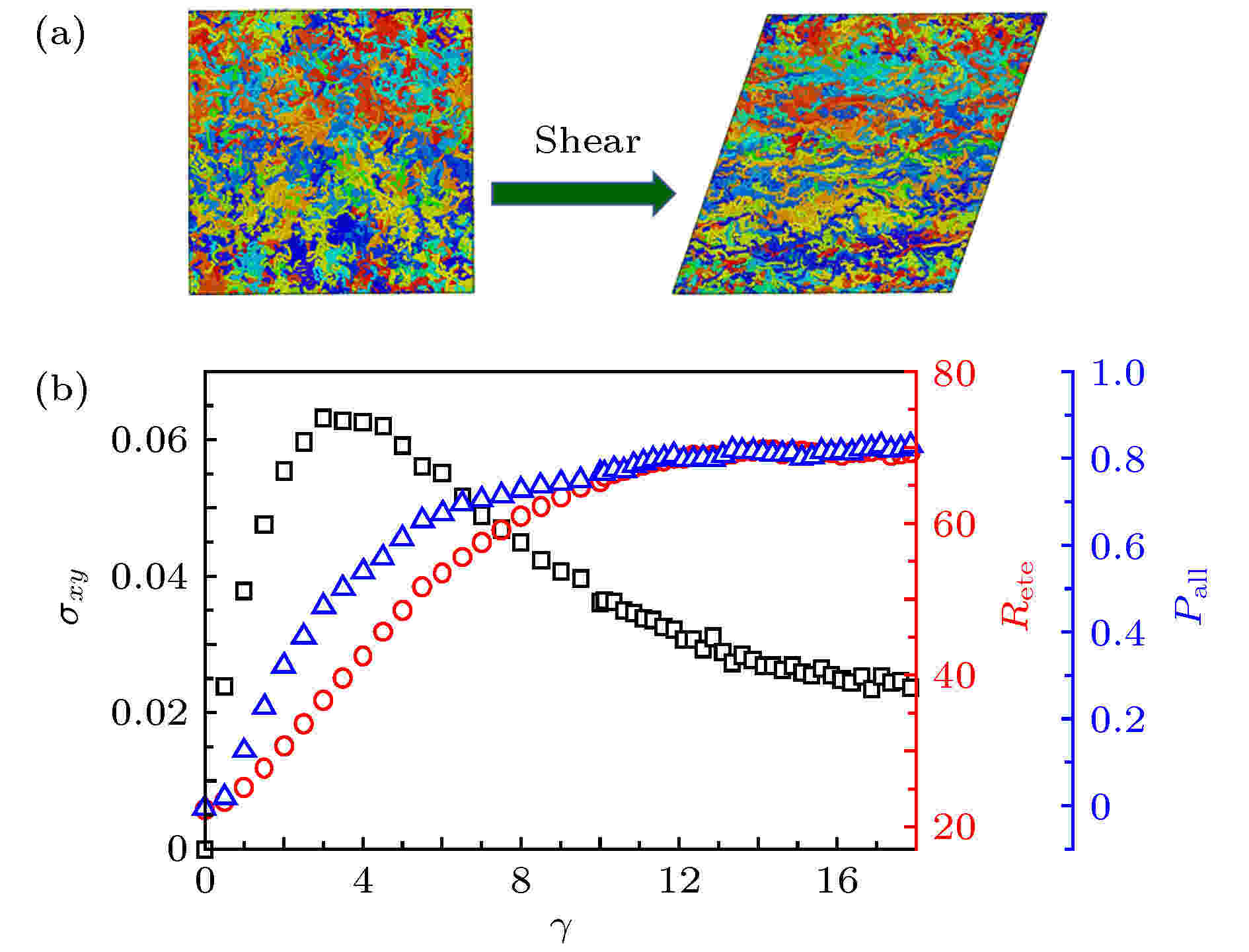
2020, 69 (3): 038101.
doi: 10.7498/aps.69.20191191
Abstract +
Molecular dynamics simulations have been used to study the effect of the pre-orientation on the microstructure of lamella crystal and the stress response of polyvinyl alcohol (PVA) semicrystalline polymer under stretching. For the different pre-oriented systems, nucleation is demonstrated to be a two-step process, however, in a different intermediate order. For the isotropic PVA polymer melt, the segment needs more time to adjust its inter-chain structure, therefore, the nucleation is assisted by local order structures, while the nucleation of the oriented PVA melt is promoted by density fluctuation. The nucleation process is the result of coupling effect of conformational and orientational ordering. The transformation from flexible chains into conformational ordered segments circumvents the entropic penalty under the shear flow, which is the most peculiar and rate-limited step in polymer crystallization. Therefore, the current work suggests that the acceleration of the nucleation rate by shear deformation is mainly attributed to the different kinetic pathway via conformational/orientational ordering-density fluctuation-nucleation. From the different pre-oriented PVA semicrystalline polymers, we know that the higher oriented degree corresponds to a higher number of Tie chains and lower Loop chains, and the higher number of Tie chains corresponds to a stronger stress-strain response. And the detailed molecular structural evolution of semicrystalline polymer under stretching is also given in this work.
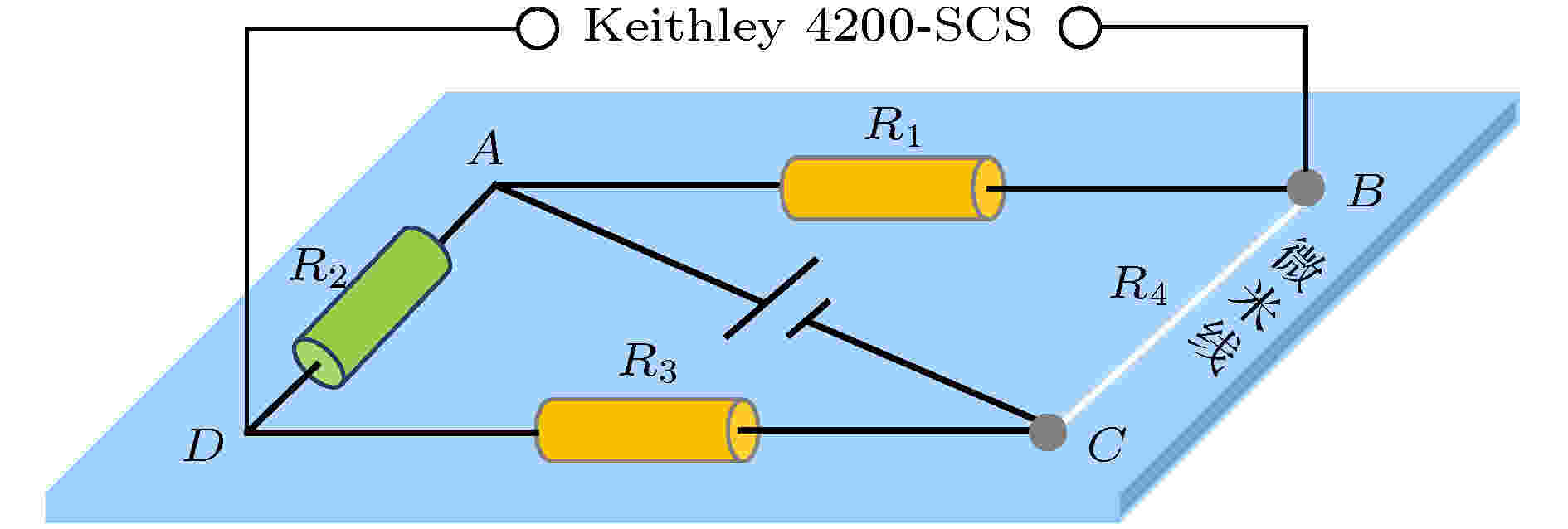
2020, 69 (3): 038102.
doi: 10.7498/aps.69.20191530
Abstract +
Zinc oxide (ZnO) is a wide direct band gap (3.37 eV) II-VI semiconductor material with a wide range of applications in light emitting devices, solar cells, field emission devices, gas sensors, etc. Over the past decades, metal oxide semiconductors have been investigated extensively for sensing various types of vapors and toxic gases. Among the various metal oxides for gas sensing applications, ZnO is one of the potential materials for high response, stability and sensitivity to volatile organic gases. At present, the ZnO-based gas sensor has a relatively high operating temperature. However, the stability and lifetime of gas sensors operating under high temperature conditions with a long term will be greatly reduced. In addition, the power consumption of gas sensors is also significantly increased. Furthermore, there can exist the potential of explosion when gas sensors are used to detect the flammable gases at high temperature. Therefore, it is necessary to improve the sensing properties and reduce the operating temperature of gas sensors. In this paper, ultra-long, large-sized Sb doped ZnO microwires are successfully prepared by using chemical vapor deposition. The gas sensor is based on the principle of non-balance electric bridge, and a single Sb doped ZnO microwire is used as a bridge arm R4 of non-balance electric bridge to produce a gas sensor that can work at room temperature. The results show that the response-recovery curves of sensors at the acetone and ethanol concentrations of 20 ppm, 50 ppm, 100 ppm and 200 ppm (1 ppm = 10–6) are rectangular at room temperature, and have stable current values in air and measured gas, and the response value of the device gradually increases with gas concentration increasing. Furthermore, the detection of acetone and ethanol gas reveal that the device has better selectivity for acetone gas. The response of the gas sensor to 200 ppm acetone is about 243%, with response and recovery time of 0.2 s and 0.3 s, respectively. Compared with the traditional resistive gas sensor, this non-balanced electric bridge sensor has high response, fast response and recovery time. In addition, the sensing mechanism of the device is also studied.
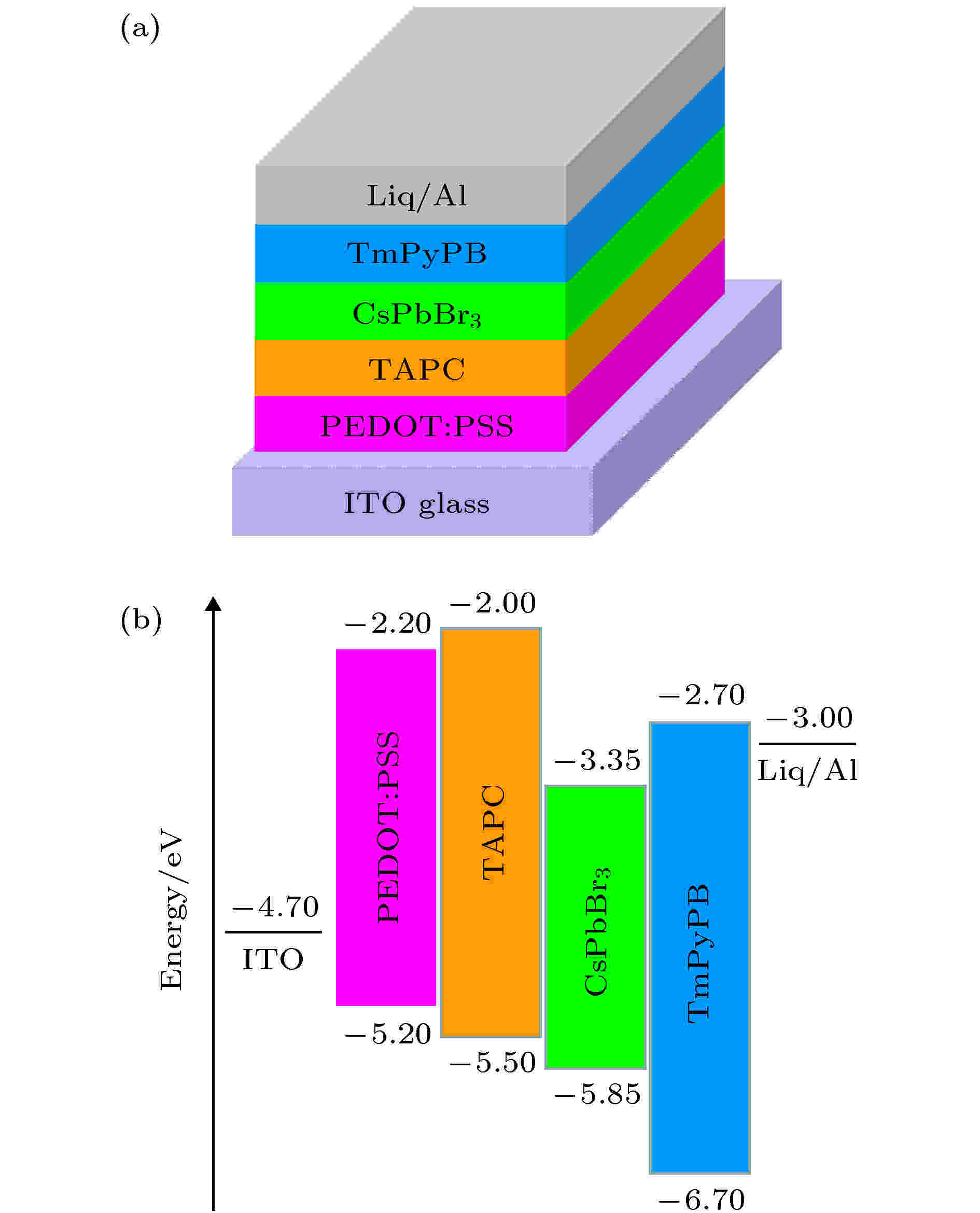
EDITOR'S SUGGESTION
2020, 69 (3): 038501.
doi: 10.7498/aps.69.20191263
Abstract +
In recent years, metal halide perovskite materials, owing to their excellent photoelectric properties including high photoluminescence quantum yield, high color purity, tunable band gap, etc., have been regarded as new-generation lighting sources and are widely used to fabricate perovskite light-emitting diodes (PeLEDs). Though great progresses have been made in recent years, neither the efficiency nor stability has not yet reached the requirements of commercialization. Thus, further improvement is needed. In this work, a small organic molecule material, namely 4,4'-cyclohexylidenebis[N,N-bis(p-tolyl)aniline] (TAPC) with a wide bandgap and a good hole transport ability, is used as an exciton blocking layer by utilizing the spin-coating method to improve the stability and efficiency of PeLEDs. Highly efficient and stable CsPbBr3 PeLEDs are finally realized. The physical mechanism related to the improved electroluminescence performance is investigated thoroughly. Firstly, the stepped energy level alignment is formed, since the highest occupied molecular orbital energy level (HOMO) of TAPC is located between the HOMO of (3,4-ethylenedioxythiophene):poly(p-styrene sulfonate) (PEDOT: PSS) and the valence band of CsPbBr3, which is beneficial to hole injection and transport. Meanwhile, the lowest unoccupied molecular orbital level of TAPC is high enough to prevent electrons from leaking into the anode effectively and confine electrons and excitons well in the emitting layer. Secondly, the introduction of the TAPC layer can avoid the direct contact between the perovskite light emitting layer and the strong acidic layer of PEDOT:PSS, thereby eliminating the related excitons quenching, which can further increase the radiative recombination.
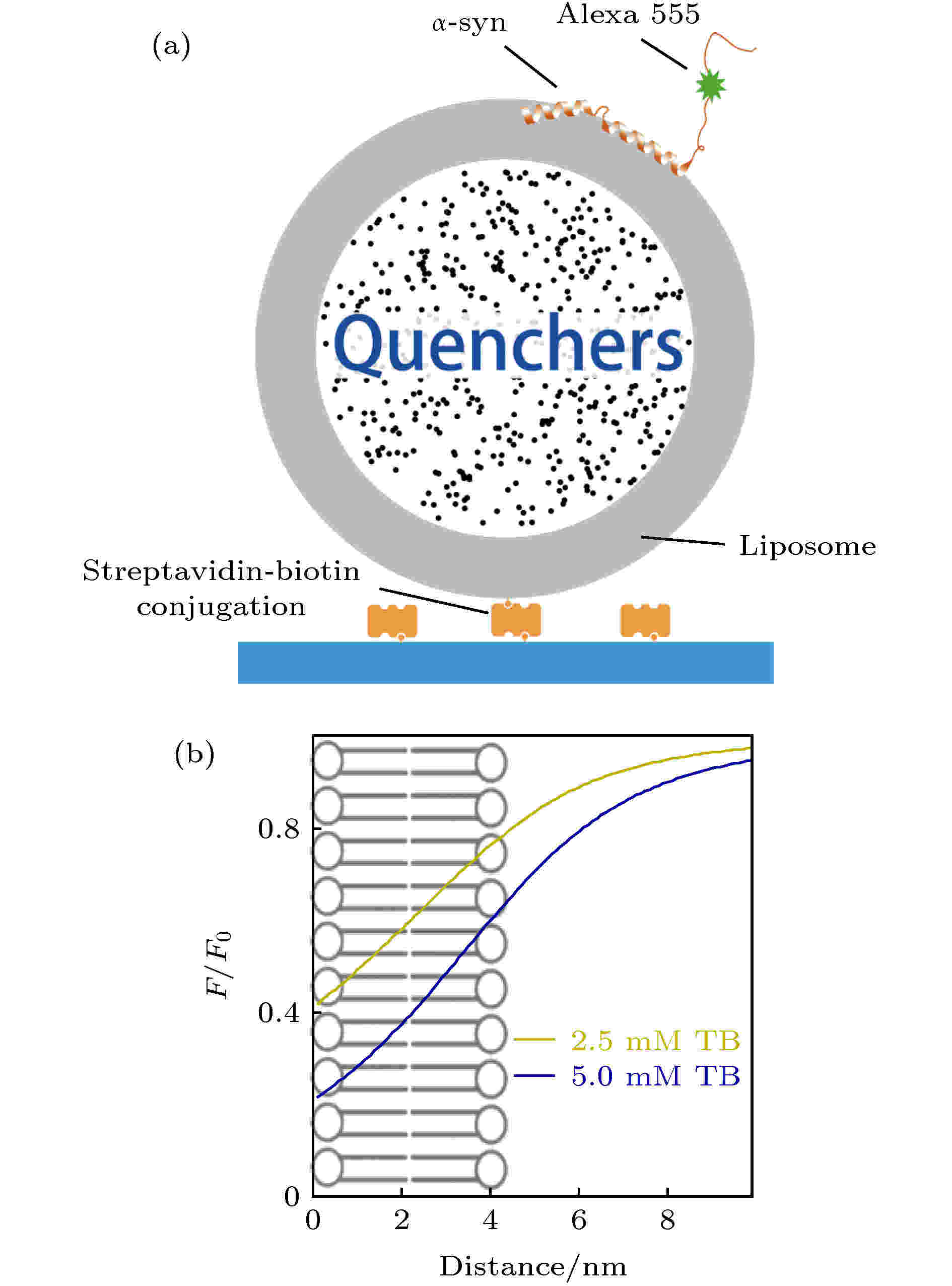
EDITOR'S SUGGESTION
2020, 69 (3): 038701.
doi: 10.7498/aps.69.20191607
Abstract +
α-synuclein (α-syn) is a key protein involved in Parkinson’s disease. There have been many researches about α-syn in recent years. It was suggested that the aggregation of α-syn may induce the lipid membranes to disrupted, which is related to the pathology of neurodegenerative diseases. Thus the studying of the dynamics of α-syn on membranes, especially in the presence of high-concentration protein, is important for understanding its function and its role in the pathology. In this study, we use LipoFRET, a single molecule method based on the principle of energy transfer between the donor labeled on the biomolecule and the quenchers encapsulated in the liposome. The quenchers encapsulated in liposomes attenuate the fluorescence attached to membrane proteins near the membrane, or penetrating in the membranes. If interesting site of membrane protein can be labeled, the LipoFRET could probe positional changes of a single membrane protein in the direction normal to the membrane. In the research of α-syn by LipoFRET, some interesting results can be obtained with different concentrations of protein. On the one hand, with the increase of concentration of α-syn in solution, the centre domain of α-syn can leave the surface of the lipid bilayer and enter into the aqueous solution. However, this domain of α-syn is located around the membrane surface at low concentration. On the other hand, the N-terminus of α-syn with three main positions at low concentration of protein, maintains three but different positions in the membrane at high concentration, where each position is closer to or above the outer surface of liposome. The above phenomena suggeste that the interaction between α-syn and membranes might be weakened with the increase of concentration of protein. At the same time, with single molecule fluorescence imaging, we also observe the promoted dissociation rates for individual fluorophore labeled α-syn from liposomes with high concentration of unlabeled proteins in solution. The result is consistent with the result of our single-molecule experiment with LipoFRET. Along with the results from LipoFRET, it could be indicated that there is a competition process where each α-syn could be occupied by the other one at high protein concentration, which leads to the dissociation. The concentration-dependent dissociation may be the property that regulates the aggregation of α-syn in vivo, which is one of the important factors that influence the pathology of the neurodegenerative diseases.



































